








Talking about quality is one thing; delivering it is another. We’ve worked hard for more than 50 years to earn our quality reputation...and to gain the trust of America. But we’re still not satisfied. We know a true commitment to quality is a never-ending process of monitoring customer expectations...and meeting those expectations better than anyone else. As a member of the armed services, you are often faced with relocation decisions. Let United Van Lines provide you with the quality service you deserve.
United’s network of over 1,000 affiliated agents in the United States and more than 100 other countries offers a full range of highway, ocean and air transportation services.



Call your United agent... call our World Headquarters at 800.283.5716... or visit our Web site at www.unitedvanlines.com



Maersk Line, Limited’s U.S. flag fleet of container, multi-purpose, tanker and roll-on/roll-off vessels provides unmatched capability to transport all types of U.S. government and prime vendor cargo. Our global reach afloat and intermodal networks ashore provide access to thousands of destinations worldwide, while our dedicated and experienced people ensure that our customers meet their most challenging objectives.

- U.S. East Coast to Kuwait—20 Days*
- U.S. East Coast to Pakistan (direct)—22 days*
- U.S. Gulf Coast to Egypt—17 days
*First arriving vessel




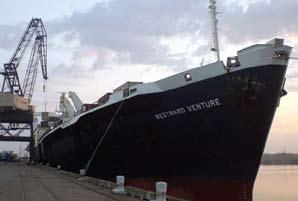

December 2009 • Vol 65, No. 6
puBlisHER LTG Ken Wykle, USA (Ret.)
EDiToR Kent N. Gourdin
MANAGiNG EDiToR Karen Schmitt | karen@ndtahq.com
coNTRiBuTiNG EDiToR
Denny Edwards
ciRculATioN MANAGER
Leah Ashe
puBlisHiNG oFFicE NDTA
50 South Pickett Street, Suite 220 Alexandria, VA 22304-7296 703-751-5011 • F 703-823-8761
GRApHic DEsiGN
Debbie Bretches
pRoDucTioN MANAGER
Margaret Howard
ADvERTisiNG AccouNT MANAGER
Jim Lindsey
ADvERTisiNG & pRoDucTioN Carden Jennings Publishing Co., Ltd. Custom Publishing Division 375 Greenbrier Drive, Suite 100 Charlottesville, VA 22901 434-817-2000, x261 • F 434-817-2020
Defense Transportation Journal (ISSN 0011-7625) is published bimonthly by the National Defense Transportation Association (NDTA), a non-profit research and educational organization; 50 South Pickett Street, Suite 220, Alexandria, VA 22304-7296, 703-751-5011. Copyright by NDTA. Periodicals postage paid at Alexandria, Virginia, and at additional mailing offices.
suBscRipTioN RATEs: One year (six issues) $35. Two years, $55. Three years, $70. To foreign post
Dr. James M. Daley
Dean, Helzberg School of Management, Rockhurst University, Kansas City, MO
Dr. kent N. Gourdin
Director, Global Logistics and Transportation Program, College of Charleston
Maj Gen John E. Griffith, usAF (Ret.) Transportation Logistics Consultant
Richard H. Hinchcliff Consultant
Brig Gen Malcolm p. Hooker, usAF (Ret.) Member, Board of Directors, NDTA
Dr. Joseph G. Mattingly, Jr.
R.H. Smith School of Business, University of Maryland
prof. Gary s. Misch, us Naval war college (Ret.)
lt col Anne T. peck, usAF (Ret.)
Dr. Richard F. poist, Jr.
Professor, Transportation and Logistics, Iowa State University
MG Harold i small, usA (Ret.) Consultant
col Joseph A. Torsani, Jr., usA (Ret.)
Dr. David vellenga
Director, Carl A. Gerstacker Liberal Arts Institute for Professional Management, Professor of Economics and Management, Albion College
EDiToRiAl oBJEcTivEs
The editorial objectives of the Defense Transportation Journal are to advance knowledge and science in defense transportation and the partnership between the commercial transportation industry and the government transporter. DTJ stimulates thought and effort in the areas of defense transportation, logistics, and distribution by providing readers with:
• News and information about defense transportation issues
• New theories or techniques
• Information on research programs
• Creative views and syntheses of new concepts
• Articles in subject areas that have significant current impact on thought and practice in defense transportation
• Reports on NDTA Chapters
EDiToRiAl policY
The Defense Transportation Journal is designed as a forum for current research, opinion, and identification of trends in defense transportation. The opinions expressed are those of the authors and not necessarily of the Editors, the Editorial Review Board, or NDTA.
EDiToRiAl coNTENT
For a DTJ Publication Schedule, Media Kit and Archives, visit /www.ndtahq.com/education_dtj.htm
Dr. kent N. Gourdin, Editor, DTJ
Director of the Global Logistics & Transportation Program, College of Charleston, Charleston, SC 843-953-5327 • F 843-953-5697 gourdink@email.cofc.edu
Ms. karen schmitt, Managing Editor, DTJ NDTA
50 South Pickett Street, Suite 220 Alexandria, VA 22304-7296 703-751-5011 • F 703-823-8761 karen@ndtahq.com

Ms. lori leffler, cTc, A-35 chair Global Government Strategic Manager, The Hertz Corporation
Our A-35 program continues to provide outstanding opportunities for young professionals and future leaders. Recently, we held meetings at the AFCEA/NDTA St. Louis Regional Forum and the NDTA Annual Forum in Nashville that included mentorship sessions. In Nashville, Mentors Ms. Fran Vollaro (SVP, The Pasha Group Relocation Services) and MG Monty Montero, USA Ret. (VP Defense Systems Engineering & Support, ARINC, and former commander of the Military Traffic Management Command, now SDDC) offered candid advice for achieving goals and for prospering both personally and professionally.
We are working with Mr. Fred Rice (SDDC Command Affairs) to incorporate a Young Leaders Mentoring & Educational Session at the upcoming SDDC Symposium. During this functional breakout, Senior Military, Government, and Industry leaders will share experiences that assisted them in their advancement as well as how best to approach, network, and interact with senior staff, the “Do’s and Dont’s.” University Representatives will share curriculum ideas to further formal education.
Attending these kinds of sessions and being an active A-35 Member has proved valuable for many A-35ers including Lt. Col. Jeff Babinski, USAF. Jeff shares his career experiences and NDTA involvement:
How does participation in NDTA and the A-35 program affect your career assignments and advancement?
The primary benefit for me is relationship-building. Chapter participation has expanded my network beyond my unit and my assigned base. There were many cases, especially during my time in Germany supporting OEF, that these NDTA-built relationships cut out the “middle-man” factor; I was able to get

organizational cooperation on missions to support troops down range. When you know Capt X, Sgt Major Y, and Col Z at the Theater Support Command or Aerial Port, you can pick up the phone . . . a 10-minute call can fix what might otherwise take a week’s worth of staffing. NDTA mentoring experiences have affected the assignments I’ve asked for, and helped when I was assigned somewhere completely unexpected. Involvement at the national level has expanded the NDTA network across the Department of Defense and across the country. I’ve also been able to reach out for advice, help, and employment leads for my Airman who have retired or separated.
What does your involvement with A-35 include?
Mostly, I’ve been involved in small chapters, where it was difficult to have a separate A-35 program (I was chapter president twice while still an A-35er). At the national level, I’ve been the Military Co-Chair, helping Lori Leffler with A-35 activities. At many past Forums, I’ve participated in and led activities including speaking at the A-35 breakfast, arranging mentorship opportunities, coordinating and narrating the A-35 Distinguished Visitors escort program for the Chairman’s Awards Dinner, and helped with the Adopt-a-Duck program.
What is the best A-35 experience you have had?
My best experience was pulling together the last European Region NDTA Forum and Exposition at Bitburg, Germany, in 2004. After postponing it several times due to OEF/OIF efforts, we gathered the European region together even though the core team was small. We received help from all of the region’s chapters and had a

Dr. kent N. Gourdin, Editor DTJ
Director, Global Logistics and Transportation Program College of Charleston
his month’s Book Shelf Ideas selection really got me thinking about the challenges companies face in balancing customer satisfaction with reality. Today’s travel security requirements can inconvenience passengers and add fees to their tickets; cargo requirements increase logistics costs and can potentially delay shipments. However, while passengers/ shippers may be upset by these negative consequences, everyone understands why they are in place. Furthermore, as these requirements are mandated and implemented by the federal government, carriers are largely held blameless in the customer’s mind for any negative experience that might result from their enforcement.
The situation is completely different when the carrier is implementing changes that customers perceive are benefiting the company at their expense. The plethora of fees now being levied by US airlines falls into this category. Passengers are being subjected to what seems to be a blizzard of charges for things that have historically been included in the price of their ticket: baggage checking, seat selection, telephone bookings, pillows, blankets, on-board food and drink, and the list goes on. The difficulty from the customer’s point of view is that the nature and amount of these extra expenses vary from airline to airline, so comparing total trip expense between carriers is virtually impossible. In many ways, the fare by itself is meaningless. As a result, customers can feel “nickeled and dimed” and even misled by what the airline is promising versus what passengers are receiving.
Unfortunately, when the Nation deregulated the airline industry in 1978, the airlines were put on notice that they would have to make money or risk going out of business. As times have changed and, especially recently, as competition has become keener, managers have had to become more creative in generating
revenues in the face of declining demand and rising fuel costs without raising fares. The idea here is that passengers should be willing to pay for services that add value, which is the essence of free-market competition. The implication is that customers can chose to buy a meal or not, to book on line or not, or to use a pillow or not. But it is very difficult to travel to Europe, for example, without checking luggage. Yes, I guess one could carry-on two bags instead of checking one, but look what’s happening in the cabin as more and more of us are doing just that. People are bringing on larger bags than they should which slows the boarding process, taxes the overhead bins and poses a potential danger to other passengers. Ironically, if/when some of these bags end up being checked anyway after a time-consuming and fruitless
search for space, they are stowed at no charge and are often the first suitcases off the plane because they were the last ones on. Go figure.
The point here is that management must be sensitive to their customers when making changes to established policies. Often, these changes make sense, and customers adapt to them, just as we all did with the security procedures mentioned above. In essence, we have come to accept them as the new normal. But some changes can appear to be so capricious and unreasonable that they alienate, even anger, patrons—a situation that cannot be good for long-term customer relations.
On another note, I enjoyed seeing many of you at the 2009 Forum in Nashville. I thought it was definitely one of the best I have attended. The sessions were all interesting and engaging, the venue and facilities were absolutely top notch, and the food was hands down the best I’ve ever had at any conference anywhere. I hope you had as positive an experience as I did, and I’ll look forward to seeing you all in Washington, DC, next year. DTJ


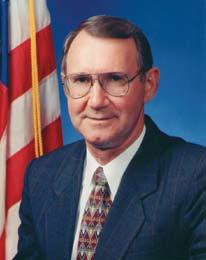
lTG ken wykle, usA (Ret.) NDTA President
n this issue of the DTJ, we provide an overview of our annual Forum events, including recognition of award recipients, exhibitors, sponsors, panelists and speakers. THANK YOU ALL for your participation, attendance and support of the 2009 NDTA Forum. Considering the recession and its impact on the economy and our members, it was a great success. We are planning for a record turnout next year. Talk to your friends and associates and encourage them to attend the NDTA Forum in Washington, DC 18-22 September 2010. We are optimistic that the economic conditions are improving and that 2010 will be an even better year than 2009! We ask that you budget and plan to support your Association in 2010, and we commit to you that we will work to provide value for your membership and keep prices low.
Each year is different and the program varies depending on location, availability of speakers and facilities. This year we offered two “off site” tours as options to the breakout sessions: the Dell East Coast Fulfillment Center and the UPS Materials Distribution Center. Although attendance was lower than registration indicated, the feedback concerning these “off site” tours was very positive. Forum attendees were also excited to all be in the same hotel, and, except for the walking, were very enthusiastic about the quality of the facilities.
Mr. Joe Bento, President CEVA Americas and Global Freight Management Network, CEVA Logistics, opened the Forum by discussing the challenges of operating a global supply chain in today’s difficult economy. General Arthur Lichte (Air Mobility Command) recognized our outstanding Transportation and Logistics units at the Military Awards ceremony. His remarks were motivational, inspiring, and appropriate for today’s airlift requirements for Afghanistan. The presentation by Mr. Richard Stocking
(Swift Transportation Company) on the current state of the trucking industry, challenges and actions Swift Transportation is taking to remain profitable was outstanding. The dialogue session involving VADM Harnitchek (USTRANSCOM) and MG Tim McHale (DLA) was a good change of pace and provided everyone with an excellent overview of the global presence of their respective commands, daily operations, and the challenges involved with providing logistics support to the forces deployed in Afghanistan. Ms. Patrice Knight (IBM) gave an excellent presentation on the evolving smart planet that was thought provoking, and that outlined ways for leveraging technology throughout the supply chain to enhance performance and productivity. General Ann Dunwoody (Army Materiel Command) provided a detailed and quantifiable summary of the retrograde, redeployment, and reset equipment requirements—100,000 pieces of equipment, 120,000 containers requiring an estimated 119 ships. General McNabb closed the Forum on Wednesday by emphasizing the role of USTRANSCOM in supporting the Combatant Commands, the need for a strong commercial transportation and logistics system, and TRANSCOM’s role in evaluating the economics and other tradeoffs between military capability and commercial capability when responding to the needs of the combatant commander.
Forum attendees had an opportunity to choose from twelve different breakout sessions which are also summarized on the following pages. In addition, the Forum Power Point presentations are posted on the NDTA website. Just visit www.ndtahq.com and click on “Members Only” on the left side of your computer screen. You’ll be directed to the Members Login and from their you can choose from a variety of resources, including “Forum Presentation Material.”
A 2010 Forum survey was distributed to Forum attendees and many responded (305 attendees completed the survey and their response follows). Thank you for your feedback!
a. Almost 95% indicated they will attend the 2010Forum in Washington DC
b. About 33% indicated they live in the greater DC area (within commuting distance of the Forum hotel). One third of these DC area residents responded that they will stay in the Forum hotel; and 67% will commute to the 2010 Forum
c. The peak nights for rooms are Sunday, Monday, and Tuesday—so register early
d. Almost 100% of our exhibitors plan to exhibit in 2010
e. Most of the 2009 sponsors plan to support 2010 events/activities
We have started to identify session topics and accept names for potential speakers for the 2010 program. Tell us your ideas. Please let Mark Victorson or me know if you would like to participate in the program or in some other capacity. Contact Denny Edwards, Patty Casidy or Leah Ashe now about exhibiting or sponsorship opportunities.
Thank you for your confidence in the Association and the daily contributions each of you make in support of our nation’s economy and to our national security. DTJ
as of November 23, 2009
SUSTAINING MEMBERS
• Parts Associates, Inc.
• Prestera Trucking, Inc.
REGIoNAl pATRoNS
• Erudite Company
• Hanjin Transportation Co., Ltd.
• Hawaii Air Cargo, Inc.
• Meyer Trucking, Inc.
• Perez Bros., Inc.
• Sleep Inn and Suites
• staybridge suites chantilly/Dulles Airport
Bennett International Group LLC is honored to serve you, our customer, the WARFIGHTER. Our Government Services division stands ready to meet your specific transportation and logistical needs. Our mission is to provide quality service, industry experts, and a responsive fleet to get the job done. Choose the company others have trusted for over 35 years. Choose Bennett, a company honored to serve.
• Continental United States (CONUS) and Outside Continental United States (OCONUS)
• Qualcomm® tracking
• Transportation Protective Services including Constant Surveillance Service (CIS), Dual Driver Protective Service (DDP) and Protective Security Service (PSS)
• Base Re-Alignment and Closure (BRAC) moves
• Unit moves
• Van, Flatbed, Dropdeck, Double drop, RGN and multi-axle specialized equipment


veterans Day November 11, 2009
by Karen Schmitt
The transition from foxhole to home front can be rough. Returning veterans may suffer traumatic injury, the loss of comrades, or other serious hardship as they confront life after Iraq and Afghanistan. According to Jerry Kykisz, board member and curator at chicago’s National vietnam veterans Art Museum, painting, photography, and other forms of artwork are a valuable form of therapy. This issue of the DTJ shares the work of two very special veteran artists in salute to veterans Day. Each has been featured in Museum exhibits, but their most notable contributions go way beyond the medium of photography and the art critic. They stay strong and supportive of those who remain on the battlefield. They provide hope on the home front. They make us all proud.


The Tigris and Euphrates Rivers were the lifeblood for modern civilization in Samarra 7000 years ago. Today, Military Supply Routes (MSR) known as “Tampa” and “Michigan” have been the lifeblood for the coalition effort in Iraq for the past seven years. Seventy-five percent (or more) of US casualties have taken place within a 10-mile corridor of these transportation routes. Danyluk’s photographs depict images along these two transportation corridors.

Veteran Artist: Steve Danyluk
Lt. Col., US Marine Corps Reserve Operation Iraqi Freedom
Steve Danyluk is a photographer who captures sweeping horizons as well as cultural portraits. Upon his return from Iraq, Danyluk became an advocate for Wounded Warriors, which led to the formation of the “Independence Fund” (www.independencefund.org), a not-for-profit organization dedicated to assisting the severely wounded in securing the freedom to live independent lives.
The organization spearheads fundraisers to help provide the tools that promote independent living for the wounded, such as the iBOT wheelchair, hand-crank bicycles, specially adapted scuba gear, and other customized athletic equipment; it also funds and promotes activities that enhance physical and emotional wellbeing, like athletic rallies around the United States; and it nurtures a network of advocacy for the benefit of wounded service members and their families.

>> visit these links and learn more about how you can help
• National Vietnam Veterans Art Museum
www.NVVAM.org
• Air Compassion for Veterans www.aircompassionforveterans.org • Independence Fund www.independencefund.org
All Veterans, regardless of service dates or conflict engagement, are encouraged to submit artwork at any time. Photography, painting, sculpture, mixed media, etc. are welcome. Exhibits are planned throughout the year by both the Museum and the Independence Fund organization.


Part of APL’s global U.S.-Flag vessel network, our upgraded Suez Express now o ers weekly P1 service between the United States and the Persian Gulf. With the industry’s fastest transits, and under our constant custody, your shipments reach their destinations swiftly, safely, and securely.
21 days Norfolk to Kuwait
22 days Norfolk to Pakistan or Iraq
For more than 160 years, we have been proud to support the U.S. government’s global transportation needs.
Any mission. Any theater. Any time. APL will get you there.
To learn more, visit www.apl.com or call 202.331.1424.

Veteran Artist: Eric Edmundson
Sgt., US Army
C Troop, 4-14 CAV
Operation Iraqi Freedom
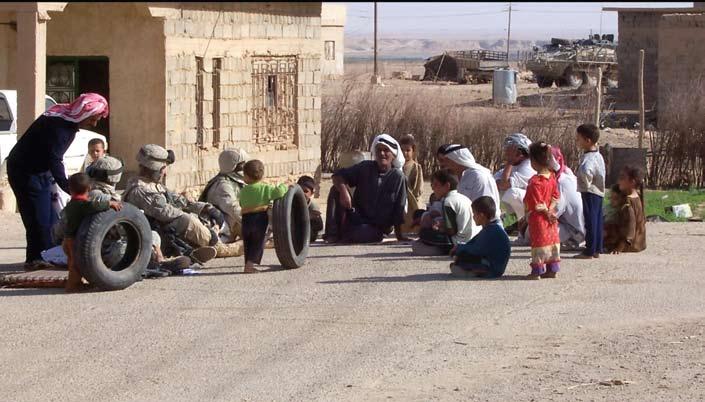

Eric Edmundson’s photographs document the interaction of fellow soldiers and the people of Iraq. The images are provocative and insightful. Sgt. Edmundson was severely wounded in October 2005 by an improvised explosive device (IED) that has confined him to a wheelchair and has rendered him cur-
rently unable to use a camera. Neither his spirit nor his determination to comfort others has been diminished. A collection of his photos will be permanently displayed at the Pentagon. Meanwhile, Eric and his father plan morale boosting outings for others: they recently coordinated and led the first Whitetail deer hunt for
wounded warriors at Camp Lejeune, North Carolina.
On October 26, 2009, Eric was the keynote speaker at an Air Compassion for Veterans (ACV) fundraising event. ACV provides free medically related air transportation to treatment centers for wounded warriors and their adversely affected

family members when other transportation is not available. Eric and his family received transport assist from ACV to the Rehabilitation Institute of Chicago; he is now able to speak via a computer.
Dressed in full military uniform, Eric saluted ACV members and his family
(wife Stephanie, mother Beth, and father Eric, standing ever-watchful by his side). He then delivered a powerful statement of thanks and affirmation on the day marking four years since his being injured—or, as he calls it, his “Alive Anniversary.”

“I am a retired US sergeant in the US Army. I was proud to serve my county. Tonight, with that same pride, I wear my uniform once again. Being injured in Iraq was a horrible thing. As you can see, my injuries were quite severe. They left me facing great challenges and in need of health care and rehabilitation. It was necessary for me to travel to many different locations. I also needed my family with me. My father left his job to be with me. It put a great strain on my family. Being injured in Iraq was a horrible thing. I miss my life—[but] the horror of war and losing my life as I knew it does not compare to how I feel—watching what being here has done for me and my family. Remember those who fight in Iraq and Afghanistan.”

On October 5, 2009, the newest Federal Government Supply Chain challenge became a reality when Presidential Federal Executive Order 13514 (Federal Leadership in Environmental, Energy, and Economic Performance) was signed and published. Order 13514 requires government agencies to set 2020 sustainability targets within at least 90 days. Combined with the H.R.2454 – American Clean Energy and Security Act of 2009, passed in July 2009, the “wait-and-see” is over. Now is the time for action.
Wait a minute. Is everyone on board? What are the implications of no action? During a recent Green Tech Media survey, 74 sustainability executives ranked improving sustainability/environmental activities as fourth on the corporate supply chain priority list. Here are the amalgamate results (priorities) from this survey group:
1. Improving Supply Chain Service
2. Reducing Supply Chain Risk
3. Managing the Supply Chain
4. Improving Sustainability/Environmental Supply Chain Activities
5. Improving Manufacturing Efficiency
6. Improving the Global Supply Base
This article offers a methodology for green supply chain transformation, potential challenges, and implications for not acting.
The Federal Leadership in Environmental, Energy, and Economic Performance E.O. implies a simple and well-crafted sustainability strategy that is applicable for big, mid-sized, and small businesses, as well as non-profits, federal, state, and local governments. The Carbon Footprint Reduction (sometimes called Greenhouse Gas – GHG) strategy most corporations are using (or will use in some form) includes Carbon Footprint Measurement; Implementation; Monitoring; and Control and Reporting. This four-step process sounds simple but could be overwhelming if not planned and budgeted for FY 2010. Here’s a high-level breakdown of the measurement to reporting phases.
GHG Measurement is the measurement of the enterprise’s impact on the environment through its carbon (CO2) and other greenhouse gas emissions released into the atmosphere. Federal contractors such as logistics companies, rail, ocean, and air carriers, lead logistics providers, brokers, forwarders, reserve logistics operators, and other supply chain partners generate CO2. GHG emissions are emitted in trucking, air cargo operations, traffic management, ocean port operations, distribution center management, travel, payroll, accounting, truck maintenance, and so on.
The enterprise first operational step beyond the planning phase is measuring the enterprise GHG and Water Footprint output. The contractor Chief Procurement Officer (CPO) and Chief Sustainability Officer (CSO) teams are key team members of this GHG Measurement Initiative because of the tier 1, two-supplier measurement requirement and technical environmental expertise. According to Executive Order 13514, a federal agency must reduce and optimize their GHG and Water Footprint by FY 2020. In order to comply with this mandate, most government agencies will incorporate this requirement into existing or future contracts in the near term. This task could prove daunting for federal supply chain providers who serve multiple agencies. Both tier 1 and tier 2 contractors must get on board sooner rather than later because of the time requirement for GHG and Water measurement and optimization.
GHG Reduction Implementation planning and execution could be the most time consuming and most expensive phase for many global supply chains. Here’s a scenario to frame the thought process: Assume a critical Distribution Center near the North Pole can only ship its product via air freight to a Rhode Island Distribution Center because of product specifications and mission requirements. If there is an alternative Supplier in the country of Iceland who can ship via ocean directly to the Rhode Island Distribution Center, the logistics provider, demand, and sup-
By John Wilkerson
ply planners must collaborate and consider carbon footprint as part of the sourcing decision-making process. In the future, GHG will add complexity to buying, demand, supply, and transportation plan-
ning organizations. Other topics that senior logisticians should contemplate during the implementation phase include:
• Tier 1 Supplier Footprint Strategy
• Tier 2 Supplier Identification & Carbon Footprint Strategy
• Direct & Indirect Spending Categorization
• Offshore versus Near Shore Sourcing Strategy
• Carbon Offset versus Carbon Footprint Reduction
• Commercial versus Government Carbon Footprint Strategy
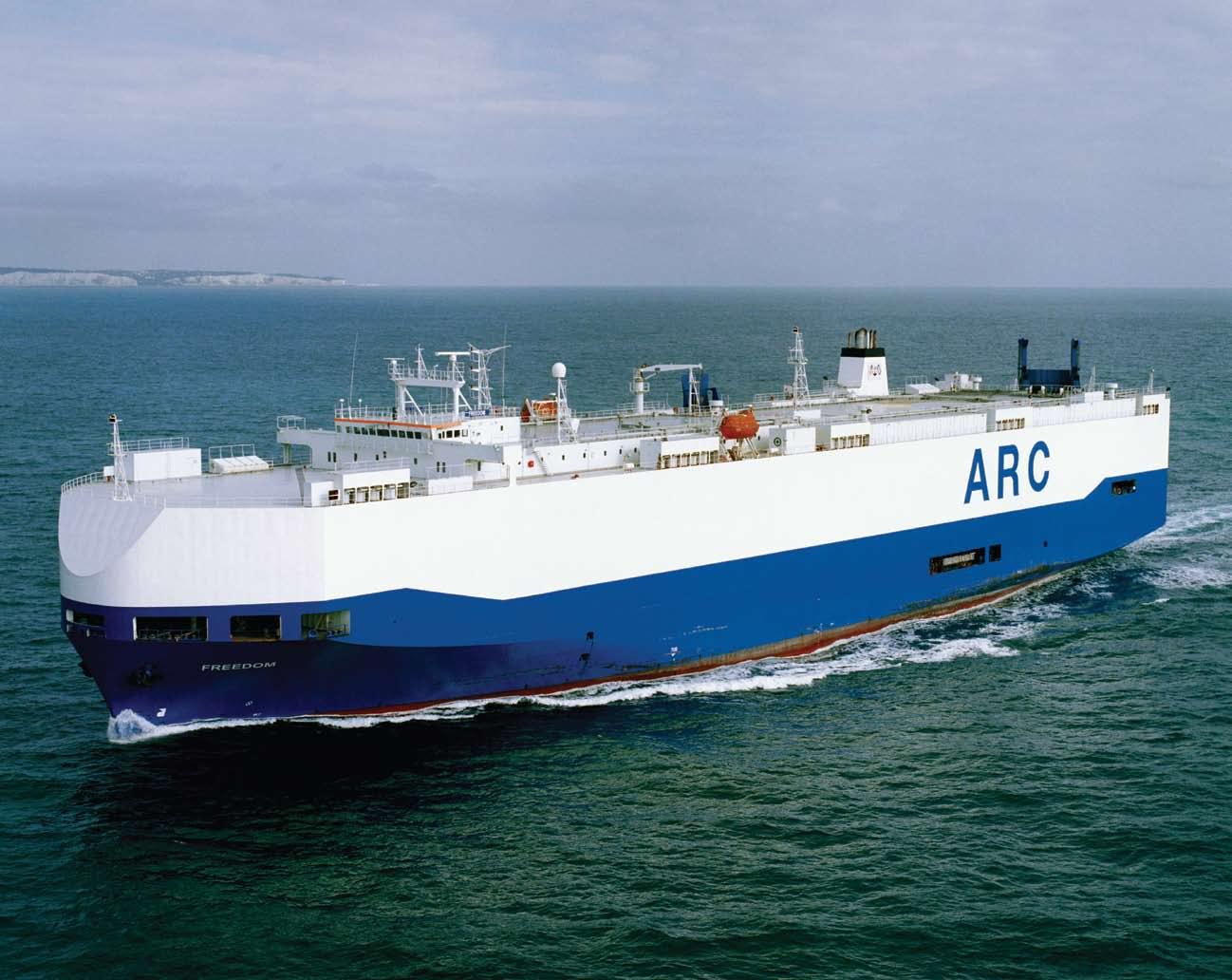




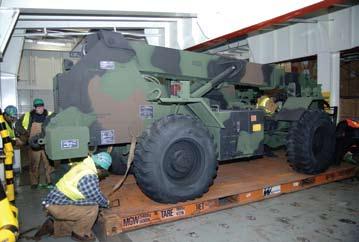
Assuming the contractor’s CPO and CSO organizations follow the Greenhouse Gas & Water Optimization path, Monitor, Controlling, and Reporting Carbon Footprint savings has the potential to be a new career field by early 2011. These duties are likely to be housed with the CSO, but the CPO must clearly be part of the integrated team. Forward thinking CPOs will incorporate metrics into existing supplier development programs such as:
• Supplier Air Emissions by Product or Facility and Category
• Supplier Water Utilization by Product or Facility
• Supplier Hazardous Water Generated by Product or Facility
poTENTiAl cHAllENGEs
The US House of Representative bill 2454 – American Clean Energy and Secu-

Miltary Surface Deployment and Distribution Command
rity Act of 2009 and Federal Environmental E.O.13514 – Federal Leadership in Environmental, Energy, and Economic Performance was crafted in response to market shifts and the global warming push. Federal Environmental Leadership and the Federal Government Supply Chain have landed on the desks of the global supply chain and CPO organizations. Carbon Footprint Reduction is the right thing to do, but challenges such as Financial (carbon credit value, carbon off-set value, implementation costs), Information Technology (stand alone or enterprise solution), Methodology (product level strategy, business unit strategy), Supply Management (supplier development, global travel category management strategy), and Reporting (federal, state, local, foreign government and/or third Party responsibilities) are key topics that must be addressed during the initial planning process. As a point of emphasis, the three most important chal-
lenges for most forward thinking enterprises are forecasting the future of the US Carbon Trading Market, US Carbon Offset Costs, and the contractor’s approach to GHG Implementation Methodology.
Is everyone on board? The corporate survey mentioned above noted that improving environmental supply chain activities wasn’t a top priority. If the survey were taken today, would the results be different? Not likely. Consequences for not integrating an initial 2010 GHG strategy, which includes strategic planning, GHG measurement, implementation, monitoring, and reporting, could impact mid-term sourcing decisions and strategic relationships, as well as most logistics costs in the coming years. Other implications for contractors who support multiple agencies could have severe internal cost repercussion as well.
“DEPLOYMENT AND DISTRIBUTION IN AN ENTERPRISE ENVIRONMENT”
Atlanta Marriott Marquis - Atlanta, Georgia
“Deployment
March 8-10, 2010
Register at www.sddcsymposium.org HIGHLIGHTS
Monday, March 8
Atlanta Marriott Marquis Atlanta, Georgia
Registration, Tack-On Meetings (TBA), Welcome Social
Tuesday, March 9
By adopting the concepts highlighted in this article, an enterprise can quickly get its arms around the new Federal Environmental, Energy, and Economic Performance reality. In the near-term, contractors can benefit from carving out time for carbon and water footprint planning and measuring. What’s the benefit? As Federal Agencies reduce their GHG and Water Footprints by 17% and 2%, respectively, the tier 1 and tier 2 contractors will reduce their footprints and internal costs as well. When is the planned benefit? By integrating this initiative into the 2010 Strategic Plan, an enterprise could see benefits in late 2010 or early 2011, a one-year ROI. Now is the time to get on board and improve our environment as well reduce and secure internal costs savings. DTJ
Opening General Session, Exhibits, Functional Breakouts
Wednesday, March 10
r E gist E r : www.sddcsy M posiu M .or G
Monday, March 8
General Session, Exhibits, Functional Breakouts, Symposium Banquet
Thursday, March 11 and Friday, March 12
Tack-On Meetings (TBA)
registration, Tack-on Meetings (TBA), welcome social
tuesday, March 9
opening General session, Exhibits, Functional Breakouts
Global Surface Transportation Experts... Committed - Dependable - Relentless!
Wednesday, March 10
General session, Exhibits, Functional Breakouts, symposium Banquet
thursday, March 11 and Friday, March 12
Tack-on Meetings (TBA)
John Wilkerson is Vice President and Global Supply Chain & Sustainability Practice Leader at Bellwether Services, a Strategic Management consultancy and Service Disabled Veteran Business offering high-performance solutions across numerous sectors. Wilkerson is a retired military officer and respected Supply Chain, Strategic Sourcing, Manufacturing, IT, and Operational Excellence expert and is writing the 2nd Edition of the Green Supply Chain Management Professional Development Series. He currently serves as the Vice Chair, Education & Training, for the Atlanta Chapter of the NDTA.
McCollister’s Transportation has been Touching Base with the Warfi ghter for more than 50 years. Now that we offer the full suite of Transportation Protective Services, we are honored to be able to provide more ways to support the Warfi ghter into the future.
McCollister’s is known for designing highly effective transportation solutions. With a national fl eet of specialized trailers, McCollister’s experience and asset-based operations provide complete single-source control.

Warfi ghter Support
• Transportation Protective Services
• Total Asset Visibility
Project Management
• Critical and Time Defi nite Moves • Custom Equipment Climate and Humidity Control
• Rocket Motor Transport Turnkey Packages For Oversize Loads
...Just Touching Base



Byrne Transportation Services provides customers with a range of transportation choices vetted by experience and solid relationships with some of the country’s largest supply chain and freight customers and service providers.
PROFESSIONALISM We possess a passion to provide worry free and cost effective solutions We engage our customers in every part of our process to ensure expectations are met.
BIG & UGLY Not just specialized equipment but a specialized skill set as well. Let us take the worry out of specialized loads
LTL Whether it’s across the street or across the country our operations department arranges the pickup, tracks the shipment, keeps the customer informed, and ensures on time performance. We handle over 12,000 LTL shipments a year.
OVER-DIMENSIONAL LESS THAN TRUCK LOAD (LTL) DRY VAN FREIGHT















September 19-23, 2009





NDTA provides a “Forum w rap- u p” edition of the DTJ to record the event for official record and to share the experience with members unable to join the event. s ummaries of keynote presentations, professional sessions, off-site learning tours, and special activities are the work of the NDTA p ress Room volunteers who are engaged before, during, and after the Forum. They study up by reading background material relating to topics that will be presented before they arrive. At the Forum, they work in teams, sitting in on sessions and joining tours to record remarks; they also get together informally to discuss and clarify information as presented. After the Forum, they forward material for compilation in the DTJ .
we are pleased to provide this record of their hard work and hope you enjoy the summary!

Shipping Logistics Group (ASL)
APL, Limited
ARINC
Army Transportation Museum Foundation
Atlas Air Worldwide Holdings, Inc.
Avis Budget Group
Baggett Transportation Company
Bennett International Group, LLC
Best Western International
Boeing Company, The
Boyle Transportation
Byrne Transportation Services LLC
CACI International Inc.
The California Maritime Academy
Cavalier Logistics
Chalich Trucking, Inc.
Chapman Freeborn Airchartering
Coastal Maritime
Comtech Mobile Datacom Corporation
Corporate Flight Management, Inc.
CorTrans Logistics
Crowley Maritime Corp.
Crowne Plaza Colorado Springs
DB Schenker
Defense Distribution Center
Defense Travel Management Office
Delta Air Lines
DHL Express
DHL Global Forwarding
Dollar Thrifty Automotive Group
DOT, MARAD
Erudite Company
Extended Stay America
FACTS NAVSISA
Faithful + Gould
FedEx Custom Critical
FedEx Express and FedEx Freight
Fine Hospitality – Holiday Inn Express
Hilton Hotels Corporation
Horizon Lines
The Hotel at Turf Valley
Hub Group
HudsonMann, Inc
IBM
Innovata, LLC
InterContinental Hotels Group (IHG)
Intermodal Transportation Institute
University of Denver
ITLT Solutions, Inc.
ITW ENVOPAK-AMERICAS
JPMO
Kalitta Charters
Landstar System, Inc.
Limitless International, Inc.
LMI
Lockheed Martin
Loews Vanderbilt Hotel
Louisville CVB
Lowry Computer Products
LTD Management, LLC
Mack Trucks, Inc.
Maersk Line, Limited
Marriott International
Marriott Waterside – Norfolk
Matson Integrated Logistics
Mayflower Transit
McCollister’s Transportation
Mercer Transportation Co., Inc.
Military Freight Haulers
Mobility Resources Associates
MSC
National Air Cargo
NDTA / A-35 / DTJ
NITAAC
Northrop Grumman
Odin Technologies
chuck Bolduc (proGov Alliance); Jeff campbell (NDTA); “Mickey” Frank; kent Gourdin (college of charleston); Miguel lake (Decision Technologies); Mike Mcveigh (McEll services, inc.); Bob Reilly (proGov Alliance)
special appreciation goes to professor larry Bray, Research professor, and students from the center for Transportation Research, university of Tennessee, for joining the Forum and assisting with reports.
like to express our sincere to our exhibitors and helping to make the 63rd NDTA Forum such a success!
Forum Sponsor/Donor
Freight Line, Inc.
Travel Defense
Development, LLC
Expedited Services, Inc.
The International Services
Arthur
Port of San Diego
Priority Solutions International
PRTM Management Consultants
R+L Global Logistics
R & R Trucking
Raith – CTS Logistics
Renaissance Montgomery Hotel & Spa
Rentacrate
Reserve Officers Association of the US
Ridgeway International USA, Inc.
Rock-It Cargo USA
SAIC
Savi, a Lockheed Martin Company
Scan Logistix Inc.
SDDC
Sealed Air Corporation
Silver State Trailways
Southwest Airlines
Staybridge Suites Chantilly-Dulles Airport
Tapestry Solutions, a Boeing Company
Tennessee Steel Haulers, Inc. (TSH, Inc.)
Total Quality Logistics
Total Seal
Totem Ocean Trailer Express, Inc.
Transportation Institute
US Bank PowerTrack
USTRANSCOM
United Seamen’s Service
United Van Lines
University of Phoenix
UPS
US Army PM TIS
UTi United States, Inc.
UTSI
WaterLink Pakistan PVT.LTD
Worldwide Aeros Corp.
YRC Worldwide
FoRuM GRAND pRizE wiNNER
col John Race, usA (Ret.), Assistant Commandant
US Army Transportation School
Caribbean Cruise compliments of YRc worldwide
Our apologies if we overlooked anyone!

Our 2009 Volunteer Spotlight shines on Cindy and Craig Thurgood for their record breaking 16 years of official volunteer service at NDTA Forums and SDDC Symposia. Craig began working on the Forum team at the 1993 Salt Lake City Forum. He had been very active in the Salt Lake City Chapter and went on to become one of its longest serving Presidents. Cindy joined her husband as a Forum volunteer two years later at the 1995 Forum in Dallas.
The Thurgoods are not as “visible” to our attendees as some of our other volunteers because they spend their time in the Expo Hall assisting Exhibits Manager Denny Edwards. Craig concentrates on getting the big rigs positioned in the Hall, as well as acting as liaison between NDTA and the exhibitors. Cindy orchestrates the popular Grand Prize drawing— soliciting gifts and recording donors and recipients. She also helps at the Sunday morning Golf Tournament. Sixteen years of dedicated, loyal service to NDTA certainly qualifies the Thurgoods to be NDTA’s 2009 Volunteers of the Year.
2009 FoRuM voluNTEERs
Chuck Bolduc • Dale Cozart • Terri Dalton • Pat DeMichele • Karen Edwards
Lisa Fasching • Taylor Fasching • Mickey Frank • Yvonne Frazier
Kent Gourdin • Marlene Jetton • Ben Jetton • Miguel Lake
Michael McVeigh • Amanda Meyer
Colt Meyer • Bob Reilly • Marie Rohrbough
Steve Rohrbough • Betty Tedder • Cindy Thurgood • Craig Thurgood
We also want to express our appreciation to Professors David Clarke, Director, and Larry Bray, Research Professor, of the Center for Transportation Research, University of Tennessee, for their support and coordination of student volunteers
A Student’s Perspective by
Sharon Watson
The Gaylord Opryland Convention Hall was filled with a broad range of transportation-related providers, eager to demonstrate and answer questions about their products and services. Land, air, and water transport firms had a definite presence. From large scale trucking firms to sub-specialty air transport firms, the displays echoed the effort and scale required for moving goods and people throughout the world. Exhibitors also displayed goods that simply facilitate travel and mobility for the people and supplies of the military. The latest innovations in prefabricated units were illustrated, and transport packing materials were demonstrated. Displays provided by the University of Tennessee’s Transportation Research Center were housed in the Education and Hospitality Pavilion, alongside exhibit booths from other colleges and universities. The UT Center display provided a unique niche for the overall Exhibition.
Large commercial vehicles parked on the display floor were a commanding presence and included tractor trailers and even a bus. One trailer fully expanded to double width to provide 1000 interior square feet completely equipped with air controls and its own power source. These special use trailers are primarily designed to meet the mobile needs of the military and disaster relief efforts, and a fleet of these trailers can be readily installed to form a small hospital.
At the other end of the spectrum were the logistics firms sharing details of the services they provide. Much of their vital work is done behind the scenes; typical tasks involved tracking containers and moving record pieces of cargo through Middle-Eastern ports to better support our US military. Some of these firms provide diversified services and products as well.

An optional excursion was arranged for Forum attendees to visit the small town of Lynchburg (population listed at 361 according to advertisements). The first stop was the Jack Daniel’s Distillery, where our guide introduced the early days of the enterprise and the process of manufacturing Tennessee whiskey. The tour was leisurely and informative and led us to towering charcoal filtration tanks, vats of fermenting “sour mash,” and a warehouse where wooden barrels, filled with whiskey at various stages of maturity, were stacked floor to ceiling. The bulk of aging whiskey is stored not at the Distillery but rather at several dozen other warehouses throughout the Lynchburg environs; many are specially built right in to the hollows. We also stopped by a bottling room where bottled whiskey moved from conveyor belts to shipping
boxes. For lunch, we dined at Miss Mary Bobo’s Boarding House, dated to 1908 and situated near the town square. The table was set with an amazing array of the very best “down home cooking”—several dishes were even concocted with a dash of Jack Daniel’s. A simple question posed over dessert prompted a lively dialogue, especially among transporters:
How can such a small town satisfy global market demands?
There was little evidence of the modern world at either the Distillery or in Lynchburg proper (the town has only one traffic light). In fact, it was easy in this setting to imagine that the whiskey was hand delivered in wooden carts.
A call to Mr. Rick Bubenhofer, Director of Public Relations at Brown-Forman,* shed some light on the subject for the

• 2008 Sales (approximate)
9 million cases
• Domestic Shipments
6300-6500/12 month period
– Intermodal 15%
– Truck 85%
• International Shipments
3200-3500/12 month period
– 20’ Containers 10%
– 40’ Containers 90%
benefit of NDTA members. He explained that although nearly all of the production at Jack Daniel’s takes place on the distillery grounds, the “real action” is elsewhere in Moore County where the main bottling line is located. Processes from cleaning the bottles through filling, labeling, and capping are fully automated. All distribution originates in Moore County via truck transport; containers bound for overseas markets move to Nashville where they are sent by rail to the port for sea shipment. Domestic delivery employs rail and truck modes. Rick said, “We rely on our well-established long-term carrier relationships. Since any Jack Daniel’s product found anywhere in the world comes right from Lynchburg, we view our carrier service providers as an integral partner in our overall distribution success. BrownForman partners with a select group of 15 to 20 carriers and ships Jack Daniel’s to more than 160 countries.” Sales and shipments increase around the holidays. Web sales also impact distribution metrics.
NDTA extends thanks to teams at Jack Daniel’s and Miss Mary Bobo’s for an intoxicating experience!

Days were full for NDTA Forum attendees, so it was not surprising that the bus bound for Dell’s East Coast Fulfillment Center (ECFC) had empty seats. There are advantages to touring with a smaller group—people could ask plenty of questions. Attendees who joined an earlier site visit remarked that it was hard to hear the guide’s explanation over the hum of activity.
The first surprise was that there were no computers in sight! Computer production ceased in Nashville in 2002, and now all components are built in China, Malaysia, and Ireland.
Operations Manager and tour guide Shawn Thomas explained that DELL has one other distribution facility supplying the West Coast from Nevada. The majority of DELL’s customers, however, live in the Midwest and Eastern United States, so 90% of their products are shipped from Nashville. Of that, 60% of the packages are sent parcel post to customers in 32 states, 20% head overseas, and the remaining 20% are sent to retail stores to stock the shelves.
The DELL ECFC opened in June of 2000 and began fulfilling orders for portables and DELL-branded products in July of 2002. The center employs up to 600 people throughout the year; most are full time, but an extra wave of part-time employees are added during the busy Fall season to keep up with school orders and holiday shoppers.
The DELL Campus stands on DELL Parkway, across the street from the 118th Airlift Wing of the Tennessee Air National Guard. Similar products coming from China might make a pit stop in Alaska; likewise, DELL computer systems spend little time in Nashville before hitting store
shelves or drop locations at customer request. In fact, the turnaround time for DELL-branded items to enter one side of the building and exit the other is almost always achieved well within the goal of 24 hours. The center has just a 3% failure rate, due to what it labels as “Missing,” “Incorrect,” or “Damaged” pieces.
Tour attendees were keenly aware of safety and security priorities—goggles were donned to enter the assembly area and only after passing through airportstyle metal detectors and security personnel. Here, DELL employees were busy moving packages from one end of the building to the other across seven miles of assembly line.
The most amazing feat of accomplishment was displayed on a wall above the entrance: 2.5 million DELL-branded packages moved through this building in 2003, just a year after domestic shipping began. That amount surged to 50 million in 2007, and the numbers continue to climb, due in large part to the affordability of computers, according to the guide. NDTA thanks Don Caldwell for making this informative tour available to Forum attendees.
The UPS Material Distribution Center (MDC) opened its door to two separate groups eager to experience distribution first hand. Close to 50 members in total joined the MDC off-site learning tours, which began with a security check, followed by a briefing on the role of the distribution center, and then a physical walkthrough of the facility.
The MDC is focused on providing automotive repair parts to the UPS delivery fleet. Virtually everything is distributed from Nashville; previously, five separate

locations provided distribution, but the others have been cut back due to process automation. The Nashville facility supports approximately 4000 mechanics at approximately 1000 shop locations that maintain approximately 72,000 package cars, 17,000 tractors, and 60,000 trailers. UPS spends nearly $200M annually in automotive repair part operations. The package cars you see on the street average 7 to 9 years old but could easily be 20 years old, or more. (“Package car” is in-house terminology for the UPS delivery “truck.”)
UPS has a very robust Fleet Management System that tracks all repairs for each vehicle and all parts used in repair. Parts life cycle between failure is monitored, and alerts are announced when vehicles are due for preventative maintenance.
Each repair part has an accompanying control tag, which is “read” when installed. Information is fed to a data file, and an automated order is sent at the cutoff time the next morning, 6am ECT, and then forwarded to the Nashville MDC for fulfillment. This process, which covers almost 70% of all inventory parts, even allows mechanics to special order items that can be automatically sent to local vendors. Approximately 10% to 15% of parts fall into this category. Mechanics typically work at night because vehicles are on the road during the day.
Sixty personnel work at the Nashville MDC to fulfill the daily orders. They complete around 9000 picks a day from 24 carousels and 1500 bins. They also process 400 lines of returns daily. The MDC also processes all automotive warranty claims for UPS returning at about $7M annually.
NDTA thanks the MDC for this informative and enjoyable tour, and Tim Shaw, Director of Government Accounts at UPS, for helping to bring this wonderful opportunity to Forum attendees.
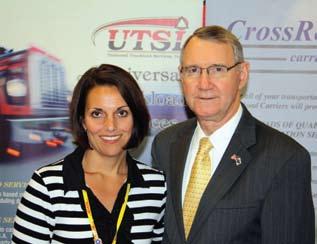
opENiNG cEREMoNY keynote Address

Mr. Joseph (“Joe”) Bento President CEVA Americas
The NDTA 63rd Annual Forum & Expo in Nashville, Tennessee officially opened on September 21 with remarks from Mr. Joseph (“Joe”) Bento, President CEVA Americas. His message was both energetic and timely—an excellent combination for launching “The Rhythm of Change.” Bento provided an overview of the logistics industry and the impact and challenges of the global economic downturn. He focused on a number of topics for his industry partners to consider for their businesses during these tough economic times, and he clearly articulated how these challenges directly affect the government sector. In addition, Bento discussed several industry trends and, specifically, noted how his company, CEVA, is responding. He expressed his strong belief that in order for any organization to pull together as a team through adversity and to celebrate through the good times, the culture of teamwork must be a top-down priority. A continual process, the demonstration and communication of the value of teamwork must be embraced by the leaders in the organization wholeheartedly in order for the value to take hold through all levels of the organization.
Some of the industry challenges and trends that were addressed:
• Inventory Management
How can industry bring value to more efficient management of inventory throughout the supply chain pipeline?
• In-Transit Visibility
Easy transfer of receiving shipment status information is critical to business today.
• Forecasting Tools
The need for better tools is critical.
• Offshoring & Outsourcing
Attractive options.
• Trends in Logistics-based Companies
Company functions are moving from a purely transactional forwarding function to a consulting function. Organizations must better understand their own supply chain pipelines and how to improve them.
• Risk Management
Both internal and external solutions are required to minimize organizational risk.
• Additional Team Players
Compliance teams are becoming an essential part of engaging in global business. Consider bringing specialists on board
• “Green” Supply Chains
Demands for green practice are increasing, as are green regulations.
Bento believes that industry acquisitions will continue and that restructuring will remain a commonplace event, adding that CEVA has adopted many industry best practices and has differentiated itself in the industry by incorporating specific elements in their corporate vision and values. These are the vital components of success: Global Network, Diverse Portfolio of Services, Smart Information Technology Systems, Experience, People, and Passion.


NDTA members, friends and industry and government leaders filled the Tennessee Ballroom at the Gaylord National Convention Center in Washington, DC, to hear Air Force General Duncan McNabb, Commander, USTRANSCOM, talk about the accomplishments and challenges in defense transportation.
“This really is a historic time—anything that goes on, you think about transportation,” General McNabb said. “It really is a tremendous time, but the biggest thing in the last 80 years is the relationship with industry.”
Partnerships between government and industry—many of which are forged and strengthened at the NDTA Forum— enable USTRANSCOM to provide the synchronized transportation, distribution, and sustainment for the nation.
A command pilot with more than 5400 flight hours, General McNabb once oversaw air transport of our nation’s leaders, including the President, Vice President, and Secretary of Defense, as commander of the 89th Operations Group at Andrews AFB, Maryland.
At the NDTA convention, General McNabb led the audience through and overview of the command and its complex challenges. “Military might moves with USTRANSCOM,” he said, and explained

how his command projects national military power through its components, the Army’s Military Surface Deployment and Distribution Command, the Navy’s Military Sealift Command, and the Air Force’s Air Mobility Command.
The USTRANSCOM team operates globally, providing air, land, and sea transportation for the DOD, in both time of peace and war. The command must operate as effectively and efficiently as possible, around the clock. The bottom line for USTRANSCOM is support of the soldiers, sailors, airmen and marines in the front lines of the War on Terror.
usTRANscoM Transformation
1986 – Goldwater/Nichols Act
1987 – USTRANSCOM Established
1990 – DESERT SHIELD/STORM
1993 – USTRANSCOM Charter (Peacetime/Wartime Strategic Mobility)
2003 – Distribution Process Owner Established
2005 – Full Time USTRANSCOM Commander
2007 – DPO lead for DOD Supply Chain RFID/AIT implementation
“We measure success through the eyes of the Warfighter,” General McNabb said. Distance lends itself to the Warfighter’s sense of urgency with each deployment cycle, especially as the focus shifts to Afghanistan—a faraway landlocked country with hostile neighbors.
The commander of USTRANSCOM doesn’t believe these challenges will slow those warriors down. “We’re going to come, and we’re going to come quickly,” he said. He pointed to advances in technology, including Radio Frequency Identi-
“If the enemy can figure out what we’re doing logistically, they can figure out what we’re doing operationally,” General McNabb said.
fication as helping the command with intransit visibility of cargo, and discussed the importance of the security of the system.
General McNabb stressed that military transportation technological advances must always be balanced with the need to protect operational security. “If the enemy can figure out what we’re doing logistically, they can figure out what we’re doing operationally,” General McNabb said.
On any given day USTRANSCOM is responsible for 35 ships loading, offloading, or under way; six brigade equivalents moving simultaneously; and an aircraft taking off or landing every 90 seconds. Air Mobility Command 9000 mile “tanker bridge” from the United States through Europe and Southwest Asia passes more than 5 million pounds of fuel every day, for a total of 10 billion pounds since Sept. 11, 2001. These numbers underline USTRANSCOM’s global presence.
For more than two decades, USTRANSCOM has played a major part in major national and international humanitarian response such as Kurdish relief, Los Angeles earthquakes, North Dakota floods, Hurricanes Andrew, Fran, Katrina, Rita and others. The command also provided aid in the aftermath of the USS Cole bombings in Yemen.
The speed and efficiency with which America’s transporters and logisticians move equipment and personnel amazes the general. “We have a force based on wartime surge—we have the ability to say we can cover two theater wars and still maintain a presence in the rest of the world,” he said.


usA Commander, AMC
General Ann Dunwoody, USA, commander of the Army Materiel Command and keynote speaker, greeted a full house on the final day of the 2009 NDTA Forum in Nashville. There were no power point slides. She spoke directly to the audience about the operational realities facing Soldiers in Afghanistan, retrograde in Iraq, and the magnitude of that combined mission. General Dunwoody also addressed other issues challenging today’s logisticians.
“We all face tough choices every day in the business of defense transportation . . . and we can either wring our hands or roll up our sleeves.” General Dunwoody was quick to acknowledge NDTA members and associates who do not shy away from difficult situations. She also commended the choice of attendees to attend the Forum, to come together among peers for the benefit of the warfighter. “You are an incredible team. Thank you for what you do year round to find solutions to the challenges that confront us. Thank you for all you do for our Soldiers, Sailors, Airmen, Marines, civilians, and contractors. The ongoing support of the commercial transportation and logistics industry is an absolutely essential element to the success of our global missions,” said Dunwoody.
She did pose sobering questions that do not have easy answers: “How can we leverage this Forum to redouble our efforts? How can we ensure that after eight years of war we don’t view our responsibilities as being routine?”

In keeping with the theme of “Change,” Dunwoody shared remarks on specific topics: the changing nature of defense logistics; the disparity between the culture and conditions we face in Afghanistan as compared to Iraq; and the transformation that we all must make in order to meet the changing needs of warfighters today and in the future.
Attention of late has been on Afghanistan, but we should not forget Iraq, where soldiers, supplies, civilians, and much more need to be removed and our footprint reduced. Every decision we make will have long-term consequences. The scale of the drawdown and reset is almost unimaginable and will require what General Dunwoody has dubbed “PhD-level logistics.”
As this issue of the DTJ goes to print, GAO-10-179 was released; relevant details are extracted below from Operation Iraqi Freedom: Preliminary Observations on DOD Planning for the Drawdown of US Forces from Iraq US Government Accountability Office; Nov. 2, 2009.
US forces in Iraq are to be reduced to 50,000 by August 31, 2010, with a complete withdrawal of forces by the end of 2011. Drawdown includes the withdrawal of approximately 128,700 US troops, more than 115,000 contractor personnel, the closure or transfer of 295 bases, and the retrograde of more than 3.3 million pieces of equipment.
There are many scenarios and “what if’s,” yet one thing is certain—Afghanistan is not Iraq. The geography, gateways, and infrastructure of each country are vastly different, and that means strategies have to be adjusted. Dunwoody assured the audience that leaders are developing new ways to
We’ve only just begun to uncover what is possible on a smarter planet.
• We are moving into the age of the globally integrated and intelligent economy, society, and planet.
• There’s no better time to start building a smarter government— and invest in creating the kind of society we all desire.
Let’s work together to drive real progress in our world. —IBM
“go light, go small, and go fast,” and that they are also searching out northern routes thanks to inroads made by industry.
A good percentage of equipment used in Iraq will be reset and redeployed to Afghanistan.
In the meantime, we all must posture ourselves for whatever decisions the Administration may make; and all the while, we must focus on our warfighters who are counting on us to provide superior logistical support.
Responsible reset and drawdown— daunting operational tasks—are being accomplished against the backdrop of roadside bombs, ambushes, and suicide attacks from insurgents and terrorists. The threats are ongoing, and we will be tasked to do more with less.
It is our job to leverage all resources to set conditions for the Army to continue operations against persistent threats. General Dunwoody made a direct appeal to the audience: “With your help we are putting mechanisms and processes in place to do just that. Every node in the distribution pipeline must be flexible, agile, and responsive.”
There was little time for questions, but General Dunwoody graciously responded to each and every one.
Most queries concerned operational matters. Someone asked what it means to be the first female 4-Star General. Dun-

woody admitted that it was a humbling experience, but throughout her career she has been the first at many things. “This proves that the Army provides opportunities to those who work hard and do a good job,” she remarked. Dunwoody has had several mentors throughout her career; she now takes on that task from afar to inspire a whole new generation of Army officer.

Ms. patrice N. knight VP, Global Supply Operations, IBM
Our world is smarter and flatter, but what does that mean? The definition takes its lead from the latest technology trends. Our planet (people, companies, communities, institutions, and man-made and natural systems) is smarter, smaller, and flatter by virtue of the instrumentation and connectivity that is available today. IBM brings a new level of smart to how we work and interact, and Patrice Knight provided an inspiring overview of what lies on the horizon.
Ms. Knight remarked that she felt humbled in speaking to a DOD audience, not only because of the awesome responsibilities that military leaders bear, but also because of the scope of the military enterprise.
Knight approached the subject of smart worlds and supply chain management from the perspective of process. IBM has conducted a study of Supply Chain operations: what SCM officers worry about; how they instill smart behavior; and how they manage risk, among other things.


4.2
2.9
The objective was to determine a methodology for developing a smart infrastructure. Measuring end-to-end success, developing smarter ways to move people and things, and taking a horizontal approach to processes and modes are starters. When it comes to moving things smarter and quicker, congestion automatically comes to mind. Knight noted that congestion pricing helps to change behavior and reduce the number of vehicles on the road, although it is not a popular idea. As an alternative, we should take a good, long look at the intermodal aspects of all movement activity. Borders are another impediment to being smarter and quicker. Consider exchange between the US and Canada (annual trade amounts to 1.8 billion dollars, the highest in the world). IBM has developed better border crossing techniques to ensure, in part, that carbon emissions are reduced. Dedicated lanes, hand-held devices, and bar coding also yield benefits that speed flow. Knight explained that it is possible to erect smarter bridges, roadways, and interchanges for a smarter infrastructure. Building or renewing these structures today means “making sure the bridge can tell us, over its lifetime, how it’s “feeling.” Traffic count and other reports affecting structural operation are possible by incorporating smart technology directly into the “blood and bones” of surface conduits.
IBM is also developing innovative container tracking systems to help supply chain managers improve container utilization and content condition. The company has come up with a food tracking solution, too—the first of its kind using RFID to track meat from the farm, through the supply chain, directly to the supermarket shelf. This could ensure delivery of fresh, untainted food around the globe.
We need to work and do smarter. Our youth expects more from their companies and Government. The tough part is finding the funds for smart solutions.
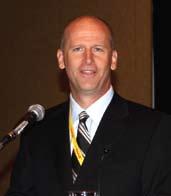
Mr. Richard stocking President & CEO, Swift Transportation
“Fortunes are not made in boom times . . . that is merely the collection period. Fortunes are made in depressions or lean times when the wise man overhauls his mind, his methods, his resources, and gets in training for the race to come.”

It was obvious to all attendees from the moment that Richard Stocking took to the stage that he was proud to be among military men and women who safeguard our freedom and national security. In fact, 914 employees of the current Swift Transportation team have served, or are serving, in our armed forces; likewise, 10,532 family members can be counted among those ranks.
On the subject of change, Stocking provided a clearly articulated and fastpaced view of the logistics industry and the wide variety of forces, both internal and external, that force change and thereby impact outcomes. To amplify the message, he supported his presentation with documented statistics—on the economy, congestion projections, fuel and housing costs, warehousing and marketplaces— and how these variables affect the industry as a whole and Swift Transportation in particular. He provided examples of how companies simply respond to trends or how they stay ahead of the curve.
The overriding message was taken from an old Chinese saying: “Insanity: doing the same things over and over again, expecting a different result.”
Change is a constant. It’s all around us and it will continue to be so. Organizations who act as change agents, or can “read the signs” early on and take action, will be the ones who thrive. According to Stocking, in order for a business to survive bombarding change, its workforce must embrace strong core values. He suggested several “wildly important goals” to sustain corporate value and vision:
• Focus on strengths
• Keep a score card at every organizational level and measure progress
• Accountability top-down
• Celebrate victories
In closing, Stocking reminded the audience that Highly Skilled Professionals are the driving energy behind today’s work-
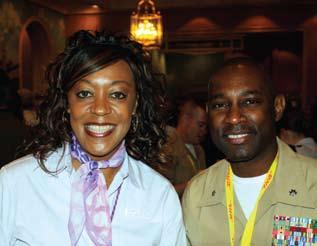
force. Dr. Ashton B. Carter, the Army’s Under Secretary of Defense for Acquisition, Technology & Logistics, recently remarked, “. . . it’s not about jobs, it’s about certain kinds of jobs: very skilled, very rare kinds of skills that are not easily replicated in the commercial world and that, if allowed to erode, would be difficult to rebuild.” Swift Transportation takes this to heart in its pursuit of the brightest and best.
RouND THE woRlD iN 90 MiNuTEs us Transportation command— Defense logistics Agency
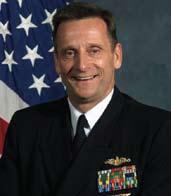
vADM Mark D. Harnitchek, usN Deputy Commander, USTRANSCOM
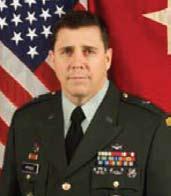
MG Timothy McHale, usA J-3/4 Defense Logistics Agency (DLA)
iNTEGRATioN | oRGANizATioN
sYNcHRoNizATioN
Partnerships between USTRANSCOM, component commands, and Industry is key to success. Communication and cargo visibility at all times is essential. In Afghanistan, it’s all about timing. Commercial carriers move about 95% of all
US Transportation Command (USTRANSCOM): Organizational components include Surface Deployment and Distribution Command (SDDC), Air Mobility Command (AMC), and Military Sealift Command (MSC). All work together with Industry to support the challenge of delivering an end-to-end deployment and distribution capability with Precision, Reliability, Efficiency, and Visibility. USTRANSCOM is made up of 145,500 people and manages $56 billion in assets. Defense Logistics Agency (DLA): DLA is a $35 billion enterprise, employing 24,000 personnel, and composed of eight supply chains that move 5 million items. When compared to commercial counterparts, it ranks #3 against the top 50 distribution warehouses. Support to Afghanistan includes subsistence, fuel, building materials, repair parts, reutilization, and marketing and distribution. The DLA also provides support for the Mine Resistant Ambush Protected vehicle (MRAP) through vendor contracting in order to meet all war fighter needs. Additionally, DLA continues drawdown in Iraq. Materiel retrograde and reset is critical in this mission, and is guided by disposal and reutilization requirements when appropriate.
cargo; they are familiar with in-country routes because of pre-existing business. Afghan terrain calls for smaller, more agile MRAPS, a need that is being fulfilled in part with outstanding effort from Oshkosh. The Oshkosh M-ATV model has 35% part commonality with the MRAP. Because of unique in-country conditions and distribution variables, other factors are equally important: Forecasting, Longterm Contracts; On-site OEM Representation; Demand Planning; Well Defined Requirements; Effective Logistics Pipe-

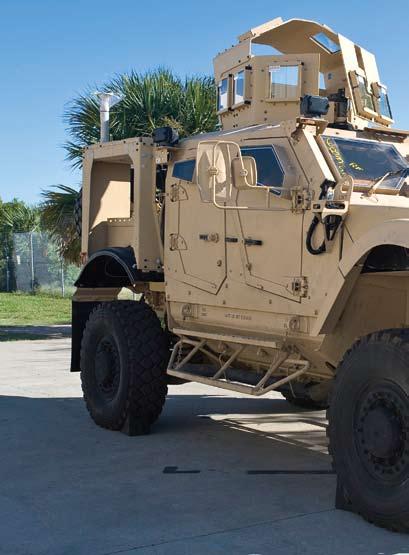
line; and Dedicated Follow-up MRAP Support in the AOR.
M-ATV is an MRAP armored fighting vehicle developed to have the same levels of protection as previous MRAPs but with improved mobility. It utilizes the MTVR chassis and TAK-4 suspension with the Plasan-designed armored hull developed for the Northrop Grumman/Oshkosh JLTV. Originally one of five candidates down selected for the M-ATV (MRAP All Terrain Vehicle) program, the Oshkosh M-ATV was chosen on 30 June 2009 to be the sole winner of the contest. The initial order was for 2244 vehicles; the order has since grown to 5219 M-ATVs for $2.76 billion. The Oshkosh M-ATV was chosen because it had the best survivability and Oshkosh had the best technical and manufacturing capabilities of all the competitors. The Oshkosh bid was also the second cheapest. The first vehicles arrived in Afghanistan in October 2009 and all should be delivered by March 2010

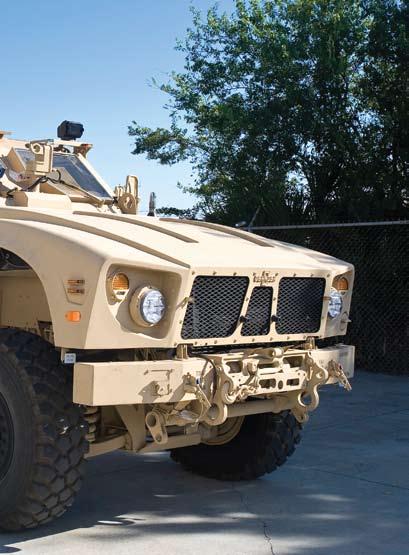
USTRANSCOM and DLA can better leverage commercial industry to be more effective by:
• Employing “Agile Transportation 101”
• Partnering with Greater Purpose
• Asking, How much outsourcing is too much? Then, finding the right mix
• Remaining Open to All Options rather than relying on a specific modal solution
• Focusing on Outcomes instead of pathways
DiscussioN poiNTs (excerpt)
Commercial carriers go to extraordinary lengths to ensure that cargo reaches its destination unmolested. For example, MRE loss in Pakistan is just 2% due to
pilferage and enemy activity, no greater rate than what carriers experience stateside. The statistic is impressive considering in-theater situations.
The Northern Distribution Network (NDN), so dubbed by General Leonard, is a team effort and is supported by APL, Maersk Line, Limited, and Hapag Lloyd. Tribal issues in northern Pakistan make it difficult to be 100% effective, and commercial carriers should get the credit for making things work. Alternate routes into Afghanistan from the North are a hot topic. In addition to the NDN, the KKT Route (Kazakhstan, Kyrgyztan, & Tajikistan) is being tested. Whatever routes are used, positive diplomatic relations will facilitate cargo flow across borders and in tribal lands.
Because networks will be upgrading, local economies will benefit. Pakistan was the exclusive supplier of resources and construction supplies, but now there are other sources. Commercial carriers who have been operational in the area for some time have established excellent networks; currently, it takes approximately 20 days to ship equipment from the US.
In some cases existing commercial distribution systems could be used rather than creating new ones; it really depends on cargo. Some items are sensitive. Furthermore, DLA is not bound to intermodal solutions; decision makers realize that processes have to be aligned from end to end.
Commercial Carriers are asked to help the DOD to continue thinking about business in other ways. The future demands the right system—a lot is at stake, and there may be less money with increased reliance on industry. TRANSCOM is counting on all partners to get it right!

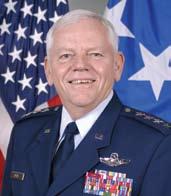
Among the awards presented at the NDTA Forum, those recognizing Military Units reflect individuals and achievements that make us all proud. This year, General Arthur Lichte, USAF, Commander of Air Mobility Command (AMC), presided over the ceremony. He noted that the event theme, “Rhythm of Change,” is a constant in defense transportation and logistics, and that without a strong partnership, the challenges brought about by changing global demands could not be met. He thanked
32nd Transportation Company – USA AC
1844th Transportation Company – USA NG
Combat Logistics Battalion 6 – USMC AC
2nd Beach Terminal Operations Company Bravo – USMC, RC
Fleet Industrial Support Center, Sigonella Italy – USN AC
Defense Energy Support Center Fuels Management Team – USN RC
332d Expeditionary Logistics R – USAF AC
80th Aerial Port Squadron – USAF RC
USCG Patrol Forces Southwest Asia – USCG

NDTA industry members, adding that AMC could not support the joint warfighter in two overseas contingency areas much less the rest of the world without the full support of commercial partners. Although only nine Marine, Army, Navy, Air Force, and Coast Guard units were formally honored in Nashville, by extension, NDTA recognizes and sincerely thanks all the men and women in our armed forces who protect and defend us everyday.
“Forward Motion”
2nd Beach and Terminal Operations (BTO) Bravo Company (“Savannah Marines”)
The 2nd Beach and Terminal Operations (BTO) Bravo Company, known also as the “Savannah Marines” because they operate out of Hunter Army Airfield in Savannah, GA, is one of more than 180 Marine Forces Reserve units serving throughout the US. Their mission is to provide forward logistical support by managing sea ports, beaches, rail terminals, air terminals, and other cargo/passenger terminal operations in seven states. Their command falls under the 4th Landing Support Battalion, 4th Marine Logistics Group, headquartered in Fort Lewis, WA, and their organizational make-up consists of three platoons, each with different skill sets. Rising to the challenges, the Savannah Marines have designed a successful missionfocused training program by leveraging area resources to pursue joint service partnerships with similar mission-oriented commands. Consequently, the Savannah Marines are able to mobilize efficiently to augment active duty forces when called upon, and their success was recognized at
NDTA’s Military Unit Awards ceremony in Nashville, TN.
Actions that gained NDTA award recognition also brought attention from the operational level of the Marine Corps. With the expansion of Marine forces in
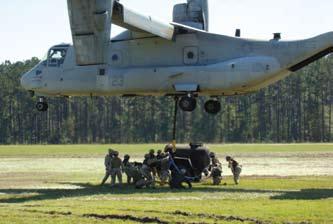
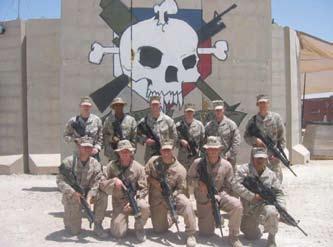
Afghanistan, Charleston Air Force Base and the Port of Charleston together have been identified as a major hub for throughput of supplies and equipment. The Marine Corps Logistics Command is in the process of collocating in Charleston with another reserve unit from the 4th Landing Support Battalion in order to facilitate requirements from the SDDC and AMC. The example set by the Savannah Marines has become the model to bring the collocating reserve unit up to speed.
Major John Sattley, commander of the Savannah Marines, shares thoughts on the success of the training model with the Defense Transportation Journal:
“DOD cost savings and efficiency are derivatives of what we are doing, but the true product is giving these Marines realistic and joint experience

in executing actual logistical operations and missions, which, in turn, gives the best measure for success when we mobilize them for OIF or OEF.
Essentially we are aligning ourselves with units that are similar in mission in order to build a relationship so we can better train our Marines and, just as importantly, learn more about the other service practices. The way we are prosecuting this war at the tactical and operational levels is joint in every functional area. Logistics is no different. Any time you can learn in an environment like this makes for great training.
While we continue to support the US Army as much as we can, we also support other on-going active and Reserve missions. And when Marines work with other units, they bring back experiences and knowledge so we can reassess our own business practices. This would otherwise not be available to a USMC Reserve unit. As a result, we are in a process of constant improvement. We are a better unit because of partnerships we have established. Our approach to training is unique given the fact that there is no official DOD or USMC mission or tasking for us to execute this kind of plan. Also, the scope of logistical support we join can never be replicated on site. We are fortunate to have other armed forces in the area who share in the vision that the best way to win is to train together as much as possible.
There are a lot of eager Marine Reservists that would love to come on orders for three to six months to execute real missions. I think with a sufficient amount of appropriated funds in support of this effort, this proof of concept has the potential of really developing into a bigger logistics mission and role for the Battalion and showcasing what these outstanding Marines can provide to transportation operations.”

AFRicoM’s ADApTivE loGisTics NETwoRk
Presenter:
Hans Garcia
Chief, ADDOC Sustainment Branch, US Africa Command Deployment
Distribution Operations Center
US Africa Command (AFRICOM) is headquartered in Stuttgart, Germany, and is expected to remain there for at least five years. The command has oversight over all countries in Africa except Egypt, the Seychelles, Comoros, and Madagascar. The Operational Logistics (OPLOG) Directorate is a J3/J4 hybrid with operations and logistics responsibility for command activities in Africa. Presently, two theater C-130s are assigned to the Command. One weekly strategic cargo “channel” operates from Norfolk, Virginia. Presently, the command does not have sufficient volume of cargo and passengers to justify intra-theater military channel missions, so there are tremendous opportunities for commercial carriers.
AFRICOM is in its infancy. This presentation offered a fascinating look at the birth and development of a new Command in an area of the world where the United States has historically had a minimal formal military presence. The Command’s strategic vision is to “improve security by building the capacity of our African Partners.” Specifically, the focus is to help develop the indigenous capacity to reduce conflict, improve security, defeat violent extremism, and support crisis response. Rather than relying on the traditional hierarchical Combatant Command (COCOM) approach, the AFRICOM is embracing an Adaptive Logistics Network that integrates the interests of the US military with those of local military, civilian contractors, nongovernmental organizations, and local Af-
rican organizations to provide meaningful solutions to regional problems.
The opportunities in Africa include rapidly growing economies, increasing democratization, emerging regional security and economic communities, and growing political will to confront challenges. Threats to the area’s security include piracy and trafficking, non-professional and irregular militaries, terrorism and extremism, ethnic strife, and ungoverned areas. Garcia noted that specific logistics challenges confront-
ing the Command and its mission are huge. Africa is a vast continent, roughly three times the size of the US, and transportation infrastructure is generally poor. The population is extremely diverse: 967 million people and more than 800 ethnic groups and 100 languages, resulting in a broad array of movement requirements of non-traditional material. Clearly, logistics is a critical part of the Command’s strategy and is key to success in this unique part of the world.
• A collection of communication processes, data sources, and management tools that will enable the effective and efficient sharing of information to support agile and adaptive logistics operations.
• Designed to operate across the full spectrum of US national security activities— engagement, development, security, combat, and relief and reconstruction operations.
• Emphasizes and enables close collaboration, cooperation, and mutual support between willing partners from DOD, other US government agencies, commercial firms, NGOs, IGOs, and other entities with common objectives.
AFRICOM is changing how it does business as a partner with the international community in Africa—ALN supports this vision.
What Is the Goal?
• Overcome Culture Differences and Perception Barriers
• Push for Pipelines and Partners, not Piles
What Are the Key Tools for Logistics Success?
• Collaboration
• Knowledge Baseline
• Collective Visibility of Capabilities
• Actionable Logistics Information
• Means to Employ Available Capability
The best information at the best time enables the best solution all warfighters need. Additionally, DLA continues drawdown in Iraq. Materiel retrograde and reset is critical in this mission, and it is guided by disposal and reutilization requirements when appropriate.
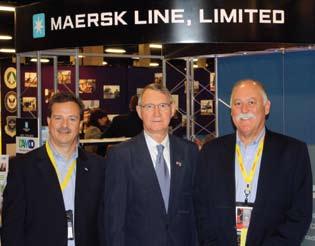

Moderator:
Mr Andrew Jones
Executive Vice President, CorTrans Logistics, LLC
Panelists:
Mr. Hellion Flowers
Chief, Inventory Management
Materiel Policy, Process, and Assessment Directorate, DLA
colonel Mike Miller, usAF Director, DTCI PMO, USTRANSCOM
Ms lisa Roberts
Acting Asst. Deputy Under Secretary of Defense for Transportation Policy
NDTA membership and previous National Forums directly contributed to the current Defense Transportation Coordinator Initiative (DTCI) program, a successful example of the partnership between industry and the Department of Defense (DOD). The 63rd Annual Transportation and Logistics Forum Professional Dialogue Session “Beyond DTCI” continued to use this partnership to explore ideas on the future of DTCI. Mr. Jones introduced his panelists, who provided some initial thoughts on the future DTCI. Ms. Roberts provided a framework from the perspective of the Office of the Assistant Deputy Under Secretary of Defense for Transportation Policy: “DTCI is an important initiative and has high visibility in the Department.” She considered this Forum as a key communications opportunity between DOD, NDTA, and industry to discuss the future DTCI. Colonel Miller touted the accomplishments of the DTCI program and expressed appreciation for the hard work from the great team that brought 52 sites into DTCI including all 18 Defense Logistics Agency (DLA) depots. Mr. Flowers stated adamantly that
DTCI is important to the agency. DLA is very interested in seeing how DTCI can be expanded, particularly regarding first destination movement from vendor to the DLA distribution centers.
Mr. Jones then divided the audience into eight groups, charging each group to discuss an assigned topic and present the group findings and recommendations on the opportunities, potential pitfalls, technology, and other options pertinent to each
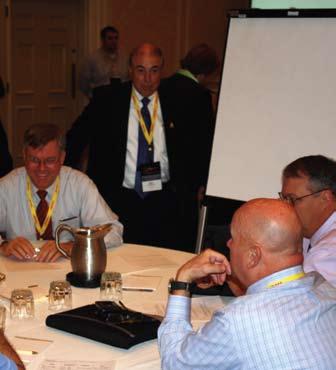
assignment. Though the topics overlapped in scope because of the complexity and interrelationships of DOD distribution, the assignments were divided into four general areas: other geographies, other commodities, other modes, and other customers.
The groups delivered many ideas on how to improve the reliability of transportation delivery and reduce cycle times while capitalizing on commercial capabilities and proven best practices. The results were wide ranging, often from both ends of the spectrum, as the groups engaged in brainstorming ideas around each assignment. In order to foster the free exchange of ideas as the groups engaged in their discussions, nothing was taken off the table. These ideas and no doubt many more over the coming years will be
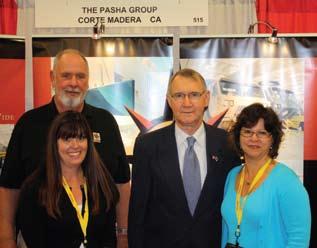
taken into consideration for future DOD initiatives in improving supply chain and transportation.
The groups saw many advantages in extending the program to other customers: foreign military sales, partner nations, USAID, non-governmental organizations working in the area of operation, and other governmental organizations such as Government Services Agency, Federal Emergency Management Agency, Homeland Defense, Department of State, and Defense Contract Management Agency vendors. Some challenges noted in regard to expanding the customer base beyond DOD and expanding to other geographies included how to handle authority to enter other nations and compliance with agreements on customs clearance processes and complying with requirements to use American Flag carriers. Some felt that the real question for the international movement was determining how to provide the opportunity for the coordinator to take full advantage of moving traffic into all lanes and leveraging the best transportation rates. An idea was proposed to do a proof of concept with the addition of targeted customers, modes, and geographies where the coordinator could develop strategies to achieve service and price efficiencies. This could demonstrate how the use of commercial practices can continue to reap cost savings.
Some saw a great opportunity for a single coordinator to bring tremendous value by providing better visibility and better rates through consolidations. The advantages could be further expanded by increased shipment volumes from additional customers and commodities with greater flexibility to access all modes of transportation. To counter concerns of exposing the Department to greater risk if all shipments are managed by a single coordinator, others proposed dividing the work into something more manageable by geographical region, commodity,

or mode. There were also concerns raised about an increased scope becoming an issue for providing full coordination and integration. On the other hand, decreasing the shipments managed by the government could lead to the loss of critical traffic management skills and erosion of the military capability to respond to contingencies. In the event of a private sector failure, the Department would not have the in-house expertise to step in and continue operations.
They wondered how the current and future worldwide express (WWX) contracts would fit into the framework of options. The small packages could bring the biggest volume of movement requirements with customers such as a depot that ships 8000 small packages a day. Technology did not appear to be a roadblock; rather, information assurance restrictions were viewed as a barrier to allowing the coordinator access to technology needed to manage, execute, or handle the movements, particularly for arms, ammunition, and explosives (AA&E). Data sharing and access to government or proprietary information systems along with security, command, and control could interfere with maintaining open communication and planning. In a data sharing environment, they felt it was important to clearly assign responsibility for the shipper of record when multiple handling by modes and carriers, which is important for resolving payment, over, short, and damage issues. When looking at adding commodities to an expanded system, no hard barriers were identified for privately owned vehicle (POV), baggage, or Code J shipments. AA&E does pose challenges because of the limited number of carriers eligible to move AA&E, extra handling requirements for security, facility requirements, and access to sensitive and classified information.
With NDTA partnerships and the participation of the panel attendees, the
Department was able to gather input, issues, and ideas from industry, military services, and customers. This information will be provided to the teams developing the future program with the goal of continuing to reduce cycle time and costs across the DOD. The next step is to complete an analysis of alternatives to assist in developing the framework(s) for future program(s), which would begin after 2015. In continued cooperation with our NDTA partners, DOD will share the results of the analysis with the Military Services and industry as we look to build a future program, providing cost-effective service to the Warfighter.
Moderator:
BG Barbara Doornink, usA (Ret.)
Senior Vice President Operations Manager for Joint Integrated Logistics & Transportation Solutions SAIC
Panelists:
Ms. Liz Lasater CEO, Red Arrow Logistics
Ms. Teresa lindauer Program Manager Defense Logistics Agency
Ms. Mary Ann wagner President & CEO XIO Strategies, Inc.
This session was designed to help small business owners gain attention from the “Big Guys” so they can build confidence, enhance their image and industry presence, seek fruitful opportunities, and ultimately win contracts. All participants were seasoned professionals who have met the challenge and who were willing
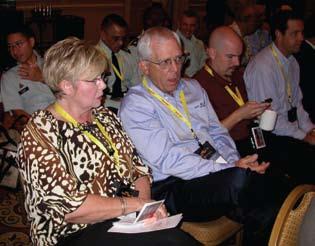
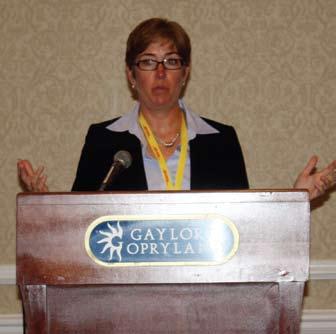
to share tips and tales based on real experience. Their vantage points differed, giving NDTA Forum attendees an extra advantage: Barbara Doornink spoke from the perspective of a large company with an established history of defense contracting; Teresa Lindauer represented a major government agency that fields numerous offerings each fiscal year; and Liz Lasater and Mary Ann Wagner are both following their dream to grow and nurture companies that are recognized and respected within the industry; they are at different stages on that journey.
sAic coRE vAluEs
• Focused on growth; small business teaming helps to achieve that end • Provides means to foster relationships and support small business through their Mentor/Protégé program
Teaming is pivotal to long-term success, and nurturing relationships is an important part of the process. Be proactive—reach out to discover where opportunities exist. Be aware of contracting companies’ Vision and Values as this is the barometer by which you can tailor your approach.

Mary Ann wagner, xio strategies
Any company looking for opportunities should zero in on what they want and what they are able to do. Target options that appeal to your company profile mission, but don’t overlook others—you can always reshape your strengths to fit and fulfill different needs. Seek out good business partners and build customer intimacy. Be sure to keep your antennae up and guard even your most seasoned relationships. Monitor FEDBIZOPS (www.fbo.gov), a good source of new business opportunities. FEDBIZOPS is organized according to Vendors and Buyers and includes informative training modules to help you navigate the site and utilize all of its components.
wiNNiNG pRiME AND suBcoNTRAcTs partner Effectively
• Rely on your reputation and experience
• Identify incumbent in target organization
• Align yourself with complementary services and solutions
• Utilize your partner’s support for small businesses (ie, Mentor/Protégé Programs)
posiTioN YouR coMpANY To wiN
• Focus on your strengths and competencies
• Shape the deal early through marketing and demand creation
• Toot your horn—past performance is key
• Network, Network, Network
lEssoNs lEARNED
• Look out for your company’s interests first
• IDIQs are only a license to hunt— work with prime contracts to market your services
• Leverage and Learn from large business processes
If you want to do business with the Government, find a niche and do it well. Understand the realities of doing business with the Government, know when and what to go after, and be sure that your efforts land you in the win column. Stay the course and stay positive. There are so many opportunities, but remember to remain focused on strategies.
• Competitive pricing
• Quick response to opportunities and requests for service
• Exceptional service and customer satisfaction
Teresa lindauer, DlA oN THE GovERNMENT siDE
The Defense Logistics Agency’s current goal for small business involvement is 23%—a figure that is projected to rise to 29.7% in the near term. Small business owners are encouraged to visit the DLA website and their online Office of Small Business Programs in particular (www.dla.mil/DB/). DLA’s scope is expansive. The organization is responsible for nearly every consumable item used by our military forces worldwide including aviation, land, and maritime weapon systems, spare parts, fuel, and critical troop-support items involving food, clothing and textiles, and medical and construction equipment and material. The Defense Logistics Agency also procures depot level reparables. Opportunities are equally expansive.

Presenter
Ms. pamela Mitchell, sEs Director, Defense Transportation Management Office (DTMO)
Since its formation in 2006, the Defense Travel Management Office (DTMO) has made great strides in becoming the single focal point for commercial travel with the DOD. Currently, the DTMO provides streamlined management and functional oversight of the Defense Travel System
Stay abreast of the latest travel news, events, and training information by subscribing to the Defense Travel Dispatch, the DTMO’s quarterly newsletter. To subscribe, visit: www.defensetravel.dod.mil/
(DTS) as the 24/7 one-stop-shop for the government traveler. Programs that fall under DTMO direction include commercial travel management; City Pair customer interface; commercial air travel unused ticket management; the Government travel charge card program; US government car/truck rental program; military bus program; and the recruit travel and assistance program. Customer satisfaction and performance management are important overall points, but there are several topics to consider as DTMO makes its way ahead. For example, the development of a strategy for next generation DOD travel services. Toward this end, the DTMO must:
• Analyze DOD’s travel programs and assess existing IT infrastructure and systems
• Identify industry leading practices through exploration and assessment

• Conduct gap analysis and study feasibility of implementation within DOD travel environment
• Develop short- and long-term recommendations and implementation plans
If you have ideas for the Next Generation of Travel, please send your thoughts and ideas to nextgen@dtmo.pentagon.mil
FRoM cARRiER oR sERvicE pRoviDER common carrier point of view
Moderator:
Ms. Gail Jorgenson
Deputy Director USTRANSCOM, Acquisition
Panelists:
Ms. Ellen Green
Chief, International Scheduled Services Division, TCAQ-I, USTRANSCOM
Ms. kirstin knott
Managing Director, FedEx Services
Ms. Lucretia Sanchez
Chief, Pricing Branch Policy Division, TCAQ-P, USTRANSCOM
Ms. cathy simpson
Chief, National Transportation Division, TCAQ-R, USTRANSCOM
This session informed attendees about recent changes to the Federal Acquisition Regulation (FAR) and explained how those changes impact service providers. Topics included performance-based and mode-neutral initiatives, FAR-based contracts versus tenders, new legislation, Defense Base Act requirements, and compliance with Cost Accounting Standards. The Directorate of Acquisition’s task is to provide acquisition capability that includes contracting and program manage-
ment functions in support of transportation and distribution for the DOD. Industry representation from the panel and from the audience addressed a number of concerns related to the expansion of FAR-Based contracts in the logistics sector. Complexity and inflexibility of the FARBased contract versus the DOD tender was a primary issue. Industry feels that customers require a more flexible structure in order for industry to respond to an ever-changing, dynamic need environment. Also, unlike a hard product or maintenance services, a firm-fixed price scenario required under the FAR contract should not restrain logistics services. The Industry “Wish List” includes a Staggered Calendar; a Price Reduction Clause; a “Take-it or Leave -it” Clause; a

• National surface and airlift contracts account for 56% of all DOD movements
• Through the Office of the Directorate of Acquisitions, more than $8B of commercial transportation services are provided in support to the Warfighter
Relevance Clause; and a more clearly defined Procurement Authorization Statement.
Government response noted that FARBased contracts will continue to be applied where possible and that there would always be a need for some degree of tender

FAR is the principal set of rules regulating the government acquisition process for goods and services. That process consists of three phases: (1) need recognition and acquisition planning; (2) contract formation; and (3) contract administration. The FAR System regulates the activities of government personnel in carrying out that process. It does not regulate the purchasing activities of private sector firms, except to the extent that parts of it are incorporated into government solicitations and contracts by reference.
The single most heavily regulated aspect of acquisition is contract pricing, which is addressed throughout the FAR documents. A large section describes several socioeconomic programs, such as the various small business programs, purchases from foreign sources, and laws written to protect laborers and professionals working under government contracts.
application where a FAR contract could not better serve the needs of the end user. Some of the successes of the FAR-Based contract initiative include:
• FAR contracts for DTCI, TTC, Southcom, Regional Intra-Theatre, and Domestic CRAF
• 130 FAR-Based contracts now in place
• Performance-based metrics in the FAR contract provide superior service to the customer
The continuing goals for the FAR contract initiative include:
• Mode neutral service requirements
• On time Pick-up, Delivery, ITV, and increased Small Business participation
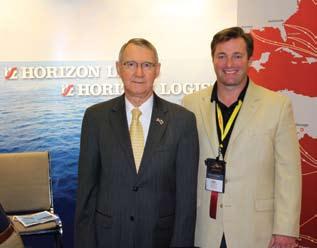
posT iRAq RETRoGRADE, REDEploYMENT & REsET
Moderator:
MG kevin
leonard, usA
Deputy Chief of Staff for Operations Army Materiel Command Headquarters
Panelists: Mr. carl cartwright
Executive Director for Field Support, US Army Sustainment Command
col Edward F. Dorman iii, usA
Surface Deployment and Distribution Command
President & CEO
Agility Defense & Government Services
This session presented Army Materiel Command’s plan to leverage the entire capability of the Materiel Enterprise to assist in maintaining asset accountability, visibility, triage, and timely disposition of equipment coming out of Iraq. General Leonard opened this session by noting that the US has never done “coming home” very well—the well known image of a helo being pushed off a carrier deck after the Vietnam conflict was used to illustrate the point. Today, however, the DOD has the capability to draw down in an orderly manner and reset equipment for use elsewhere. Leonard further emphasized the magnitude of this challenge by noting that by August 2010 the US will have 50,000 troops in Iraq; by December 2010, all of them must be out. Colonel Dorman noted that the US has already outfitted a brigade going into Afghanistan from equipment drawn down from Kuwait. He also cited the important role played by industry partners. Mr. Cartwright said that redeployment would require the movement of 59,000 containers and almost 52,000 pieces of rolling stock.
General Mongeon provided an industry perspective, commenting that logistics is
very much a team sport. The DOD relies on commercial logistics partners to deploy the equipment; those same relationships can and will be leveraged for the return to CONUS.
One point emphasized was that ALL equipment will fall under this program: military, government, contractors, etc. The reality is that most need depot-level maintenance, which simply cannot be done in Europe. Furthermore, nonreparable items will be left behind, as will equipment transferred to Iraq through Foreign Military Sales. Once items are returned and refurbished, they will be allocated to new units, existing units,
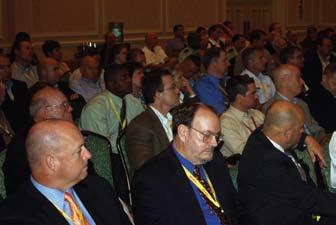
The presentation made clear that the DOD plans to recycle as much equipment returning from Iraq as possible, which is good news for both the military and the American public.
or pre-positioned stocks. Finally, some things will simply be, for whatever reason, deemed uneconomical to repair and will be disposed of.
The presentation made clear that the DOD plans to recycle as much equipment returning from Iraq as possible, which is good news for both the military and the American public.

FRoM THE FRoNT
Moderator:
Major Jeffrey Babinski, usAF Commander
11th Logistics Readiness Squadron
Panelists:
First lieutenant Aaron Hiatt Executive Officer, 32d Transportation Company, Bagram, Afghanistan
First lieutenant Adam van lear SDDC, Ft. Eustis
Mr. Dave underwood
Director, Business Development, UPS
First Lieutenants Van Lear and Hiatt provided an account of life on the ground in Afghanistan that spanned eight years since 9/11, and Dave Underwood shared his experiences as an Air Force reservist flying rescue missions in Africa.
Lack of infrastructure and hostile attacks restrict ground transport in Afghanistan. The terrain is varied, roadways are barely passable, and alternative routes are few and far between. In town and throughout the countryside, military vehicles travel alongside cars, carts, and wagons, and soldiers are tasked to direct traffic. They also provide armed cover against insurgents so convoys can pass safely. MRAPs, which protected ground forces in Iraq, are not feasible in parts of Afghanistan, so surface travel is more vulnerable. The condition of equipment and vehicles is poor, and the Area of Responsibility (AOR) is expansive. One battalion, for example, is responsible for an area 25 times the size of Bagram. Consequently, transporters often depend on host nation vehicles to complete the mission. That’s a rough go—it tests the transporters’ skill in cross-culture

communication and negotiation. Despite the obstacles, young leaders moved forward and developed an amazing record of logistic successes and delivery of needed material to front line troops.
Dave Underwood, reserve pilot trained in combat rescue, spoke of a different type of “front line” encounter. He was sta-
During his time in Africa, there were two attempted coups and a government was overthrown. “The political landscape can change rapidly. There was always the possibility that government in the area you are planning to work could not be in place tomorrow.”
tioned in Africa at Camp Lemonier, a former French compound in Djibouti, and flew rescue missions of all types throughout the continent. Sometimes, equipment was compromised; Underwood recalled an incident when his unit was forced to pull parts from one airplane to keep another one flying.
Missions in Africa are unique for many reasons including diverse terrain, geographic size, and political instability. Djibouti is a safe base, but crime is high, and the threat of terrorism is ever present. Communications are problematic due to the size and lack of African infrastructure, compounding the fact that no real organic African rescue forces exist. Underwood explained, “We could be sent at anytime to support rescue operations through the extended AOR.” During his time in Af-
rica, there were two attempted coups and a government was overthrown. “The political landscape can change rapidly. There was always the possibility that government in the area you are planning to work could not be in place tomorrow.”
Moderator:
Mr. larry larkin
Director, Competitive Strategies, Northrop Grumman Information Systems
Guest Speaker & Mentor:
MG charles Fletcher, usA (Ret.) Director of Logistics Command & Control
The Boeing Company (Fairfax Station, VA) NATO Senior Mentor for the Commander of NATO Joint Logistics Support Group
Larry Larkin opened the session commenting on the importance of mentoring and the obstacles to making each mentoring relationship a success. Interestingly, there are usually twice as many mentors available as mentees. As a result, the expansion of the logistics mentoring program is particularly dependent on the participation of the younger members of NDTA (A-35 group). To date, A-35 membership in NDTA is progressing well.
What is mentoring? MG Charles “Charlie” Fletcher defined it as “a developmental relationship in which a more experienced or more knowledgeable person helps a less experienced or less knowledgeable person to develop in a specified capacity.” Charlie stated, “The importance of mentoring is defined in the writings of many individuals, but particularly by 90-year-old Regina Brett, writing in the Plain Dealer, Cleveland, Ohio, ‘Life isn’t fair, but it is still good . . . If life isn’t fair, how do you play it?’” The answer may be to take every advantage of what life offers, including the advice from more experienced and often
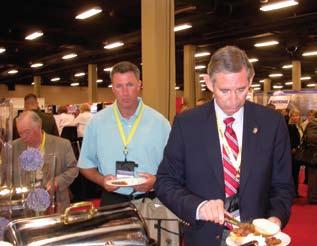
wiser individuals on how to improve the quality of life in both your business and family environments.
According to Charlie, “Mentoring is important for several reasons with a process of definable steps:”
• Deliberate learning is the cornerstone
• Both failure and success are powerful teachers
• Leaders need to tell their stories
• Development matures over time
• Mentoring is a joint venture
Charlie shared some of the obstacles that defined his early career-building challenges:
• He did not have a mentor for much of his early career
• He was not as successful as others, even those that he thought had equal talent
• He choose jobs based on their fun factor because no one advised him differently
• He believed that if you worked hard and did the right thing, you would be successful and get the promotion
When senior officers started to mentor Charlie, his career improved. His mentors advised him to change his career field. He was mentored in both the technical and developmental areas to enhance his success in the new career field. Charlie said, “I would not be here today enjoying the success I have without them.” Charlie recognized the positive effect that his mentors had on his career and decided to repay that gift by being a mentor to others. Today, he is assigned as the NATO Senior Mentor for the Commander of the NATO Joint Logistics Support Group. He currently mentors for the following programs: Boeing’s Junior Logistics Program, Army’s Theater Log Course students, University of North Carolina Business School, and NDTA. He has mentored subordinates,

but believes that being a generation removed makes mentoring more successful.
Charlie shared his most memorable mentoring experience, which was surprisingly not related to his work career. In 1995, he volunteered to mentor at an elementary school and became a mentor for a 4th grader who was a gospel singer in his church. The student shared his knowledge and talent for gospel singing with Charlie. Each had a shared responsibility in learning: Charlie in gospel singing and the student in reading, science, and math. Although the student improved tremendously through the mentoring, Charlie didn’t improve much on his inability to carry a tune or get any semblance of rhythm in his delivery, but he never lost patience.
Don’t forget that the value of the mentoring relationship is shared by both the mentor and the mentee, which adds to life lessons for both. People we come into contact with throughout our careers have
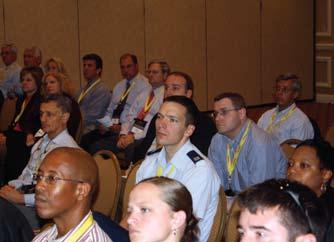
in some way helped place us where we are today. As the Danish philosopher Soren Kierkegard pointed out, “Life can only be understood backwards, but it must be lived forwards.”
To summarize, following a quote from Charlie: “Find someone successful in the area in which you want to improve yourself, take the time to check your alignment with that person, work to build that mutually supportive relationship, and enjoy the ride.”
NATioNAl DisAsTER loGisTics
supplY cHAiN cooRDiNATioN
Moderator:
Mr. Eric smith
Assistant Administrator, Logistics
Management Directorate, FEMA
Panelists:
BG Michael “Mike” Dana, usAF Director for Logistics, J-4 NORAD and NORTHCOM
Mr. John Hall, sEs
Executive Director of Operations & Sustainment (J-31), DLA
Mr. Edward Hecker, sEs
Chief Office of Homeland Security & Provost; Director, Contingency Ops and Homeland Security; Marshal, Northwestern Division RIT; US Army Corps of Engineers – Headquarters
Mr. kevin Moore
Operations Integration Branch Chief FEMA Region VIII
Disaster Operations Division, FEMA
Mr. Joshua sawisiak
Senior Advisor to the Administrator Acting Chief, Emergency Response & Recovery Officer, GSA
“We cannot wait for something to happen before we get controls in place”
Hurricane Katrina prompted lessons learned on many fronts. With regards to the Federal Emergency Management Agency (FEMA), prerequisites include agency collaboration and support at local and national levels and coordinated private and public partnership. This session presented the details of the national disaster response plan developed in the aftermath of Katrina.
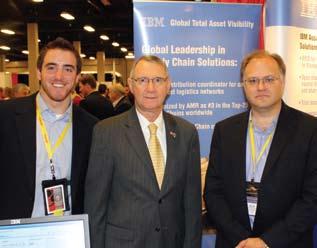

“We work as a government team that functions on a daily basis”
In the event of a natural disaster, the federal government (through FEMA and GSA), DLA, and the DOD (USNORTHCOM, DLA, and the Army Corps of Engineers), along with relevant private sector representatives, will partner to provide a coordinated response overseen by a National Logistics Coordinator representing both FEMA and GSA. The intent is that this be a bottom-up system with local requests flowing into the joint response center from the state(s) affected; the federal response must then follow within 24 hours. Funds flow to support these efforts once the President declares a natural disaster; “peacetime” funding is the responsibility of each partner. Efforts focus on pre-landfall (72 hours prior to the event) and sustainment (getting the area back on its feet after the event).
Specific agency responses are varied. GSA, for example, is responsible for arranging and managing space, travel and transportation, procurement, personnel, and telecommunications services. USNORTHCOM coordinates any requirements involving the military services. DLA is the point of contact for food and fuel, and the Corps of Engineers focuses on public works and engineering. In 2008 alone, FEMA coordinated more than $1 billion in aid to support 75 state declarations, 17 emergency declarations, and
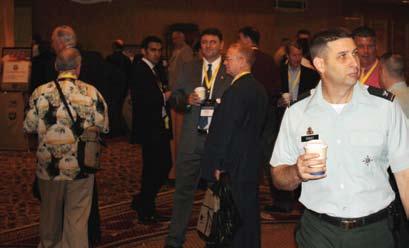
3361 eTaskers or submitted requests for aid. Clearly, the objective is to ensure that all federal, state, and local entities are able to provide both a rapid and complete response to natural disasters in the future.
THE NEw silk RoAD Afghanistan logistics support
Moderator:
Mr. Rick Boyle
VP, US Flag Transportation Services Maersk Line, Limited
Panelists:
Mr. David Dias
Chief, Asset Visibility Division USTRANSCOM TCJ5/4-1
col stephen E. Farmen, usA Commander, 598th Transportation Group
BG peter s. lennon, usA Commander, 316th Expeditionary Sustainment CMD
Past Director, USCENTCOM
Mr. lars Magnusson Director, Military Trade APL Limited
col. Rod Mallette, usA (Ret) Global Account Manager Agility Defense & Government Services
Rick Boyle opened this session by introducing the distinguished members of his panel, representing CENTCOM, SDDC, APL, Agility, and USTRANSCOM. The primary challenges they are dealing with in Afghanistan are unique. It is a landlocked country with an infrastructure unlike any we have seen in other conflicts. Panelists described other difficult situations and solutions.
BG Peter Lennon, USA, reviewed the overall approach to supporting the war-
The primary challenges in Afghanistan are unique. It is a landlocked country with an infrastructure unlike any we have seen in other conflicts.
fighter in Afghanistan and restated General McNabb’s directive to use existing commercial resources in the AOR. He also emphasized the need to reach out to Industry and take advantage of the “Best of Breed.” His presentation focused on the challenge and how the best approach would work. Key elements to the approach are to:
• Work with our traditional distribution partners (DOD, commercial carriers, 3PLs, Government of Pakistan) to better manage existing flows through the Pakistan Ground Line of Communication (PAKGLOC).
• Re-invigorate the use of non-traditional trade routes and expand the team of partner nations to develop a Northern GLOC.
• Procure goods and services from local sources wherever practicable and appropriate.
Colonel Stephen Farmen, USA, focused on the Northern Distribution Network (NDN) and the importance of Precision, Velocity, Reliability, and Visibility. He also stated the critical need to leverage commercial partnerships, manage disruptions, and win the information domain every day. Key players are TRANSCOM, EUCOM, CENTCOM, AMC, DLA, SDDC (HQs, 598, 595), GSA, and Commercial Carriers. The way ahead is critical, and we must be mindful of developing new routes, multi-modal options, risk management, and preparing for retrograde options. Thoughtprovoking takeaways that Colonel Farmen highlighted:

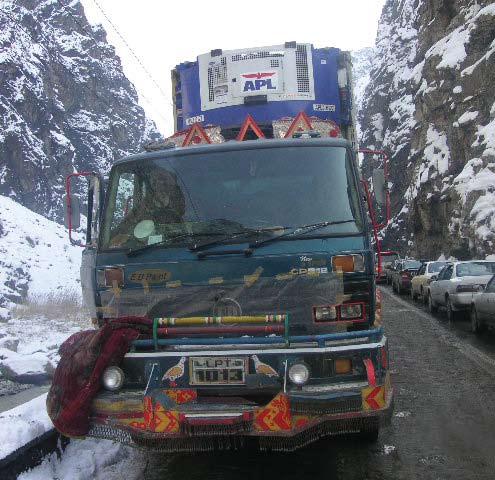
• First 1000 TEUs took 5 months; now delivering 1000 per month and moving toward 1400 per month
• Keep all routes lubricated
• Pressure off PAKGLOC = 35% and growing
• Logistics Paradigm Shift
• New Normal
– A lot of NDN benchmarking and modeling maps to AFRICOM
– Expeditionary use of USC 6
– Synchronize expectations with carrier capabilities
– Over the horizon logistics—to the point of impact
• All logistics is local
• NDN approach
– Enhance supply chain security
– Build resilience and adaptability
– Reduce logistics footprint; breed collaboration and unity of effort
Lars Magnusson described the challenges APL faces on a daily basis with security and pilferage issues and the precautions that must be taken. Using the map from Kara-
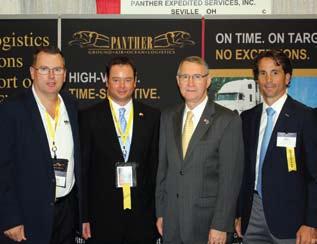
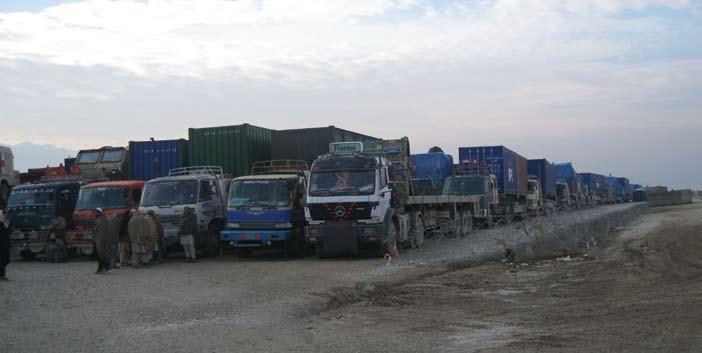
chi to Afghanistan to illustrate the point, he described the need for velocity to make northern routes work. Any backlog at ports and terminals raises visibility and create additional security needs. Other hurdles that APL faces are border closures, Peshawar attacks, secure warehousing, and vehicle encasement. APL is using a variety of security measures including high-security seals, container door-facing-door loading, ITV, multiple weighing, armed escorts, and GPS to keep pace with the challenges. Satellite tracking with direct feeds to USTRANSCOM has also been implemented. These precautions work! To date, the carrier has had less than one-tenth of one percent pilferage in Afghanistan—a very impressive fact, given the environment.
Rodney Mallette described the progress Agility has made since 2003 to improve procedures at Forward Operating Bases (FOB) in response to continual threats on personnel near Peshawar and within Afghanistan, among other challenges:
• Lack of container prioritization
• Carrier’s driver is not informed when trucks are reloaded with export cargo
• Carrier’s driver not receiving proof of delivery
• Customs–Tariff memo procedures are inconsistent
Dave Dias addressed the PAKGLOC and the Satellite Pay-for-Information, which allows for automatic updates into the DOD ITV system by the carrier industry. This represents a true Industry partnership and gives our Commanders additional options. ITV is somewhat limited due to fixed RFID infrastructure, and this is an area that needs improvement.
A commitment to Excellence & innovation
Moderator: Mr. Michael Babiak Manager, Government Services McCollister’s Transportation Group, Inc.
Panelists:
ltcol Daniel Bradley, usAF, sDDc Deputy Chief of Staff for Personal Property, SDDC Headquarters
col. Michael (“Mike”) Miller, usAF Acting, Program Executive Officer USTRANSCOM/TCAQ
LtCol Bradley briefed attendees on the current status of the Personal Property

Program. The current program—Transportation Operational Personal Property Standard System (TOPS)—will continue alongside the new program—Defense Personal Property Program (DP3)—for at least two more rate cycles until the hardware/software system known as Defense Personal Property System (DPS) is fully functional. Bradley explained that the decision to open the program to new Trans-
Dps upDATE (as of 19 September 09)
• 113 Government Bill of Lading Locations (GBLOCS)/Personal Property Shipping Offices (PPSOs) Participating
• 71,499 Members Counseled
• 61,446 Shipments Awarded
• 36,592 Shipments Delivered
• 45,000+ Invoices Paid
• PPSOs have processed approximately 18% of DOD Shipments
portation Service Providers (TSPs) was pending. Currently, 983 TSPs participate in DP3. (Editor’s Note: On October 5, it was announced that new entrants will not be entertained at this time. The decision will be reviewed as DP3, and the related DPS system gains maturity and stability.)
Bradley also discussed a key point of interest to Services and Industry: the Customer Satisfaction Survey (CSS). In DP3, an online questionnaire completed after a move is now a pivot point in the business of moving military families and their household goods. For the first time, the CSS gives the service member the opportunity to have a significant voice in ongoing TSP selection. Not many government acquisition processes can provide that option. A continu-

• Full Replacement Value (FRV) protection
• Direct claims settlement between customer and TSP
• Self-counseling available 24/7
• Move initiation and status tracking online
• Reduced storage costs and claims infrastructure for services and agencies
• Electronic payments to TSPs providers via PowerTrack
• Preferential award of business to quality vendors (BVS Scoring)
ing area of concern to all is increasing the rate of completed surveys. All Services, as well as industry stakeholders, are working toward this end. Bradley voiced the need to ensure that critical mass on statistic validity is reached in order for the survey scores to contribute positively to Best Value Scoring.
Colonel Mike Miller, USAF, newly assigned as Program Director for the Joint Program Management Office (JPMO)–Household Goods Systems, briefed attendees on DP3 status and plans for improvement. “Our first priority is to improve system performance prior to the May 2010 peak season through improved stability, robustness, and usability.” Upcoming plans include an Oracle platform upgrade and additional server power before year-end. “As we upgrade‚ we will continue to roll out new capability. JPMO is planning a military services assessment of Personally Procured Move (PPM) functionality. Once online, this capability should almost double the number of shipments that may be processed in DPS.”
Another example of progress is the DPS Help Desk. In August‚ more help desk tickets were closed than were opened.
In response to audience questions, Col Miller dispelled rumors that the House-
On September 19 at the start of the NDTA Forum, NDTA’s newly formed Household Goods Subcommittee (HHGS) was introduced at the NDTA Surface Committee meeting by Chairman Jeff Pundt, Landstar System, Inc. On September 21, a separate HHGS meeting was held. Attendees, 29 in total, included military and industry, as well as USTRANSCOM and SDDC representatives. Chairperson, Fran Vollaro, The Pasha Group, introduced subcommittee goals and proposed issues that committee members could work on to further mutual interests of all stakeholders. Lively discussion produced several agreed upon actions, and the group decided to continue work by teleconference over the coming months. The main goals and action items are:
1. Work with each Service and SDDC to increase rate of Service member response to customer satisfaction surveys after delivery at new duty station. A high rate of response is crucial to obtain valid data, which affect scoring and TSP Best Value placement according to the new DP3 program. Service member satisfaction with the program in general is also an important criterion.
2. Full Replacement Value Insurance. Ensure that the Service member fully understands terms (ie, repair versus replacement, need to document high value items) and provide a means for dialogue and sharing of improvement on all fronts. A smooth working program results in efficiencies for SDDC, the military, and commercial industry. Accurate and timely claims data will help reduce incidence of preventable damages. An easy-to-use filing process will result in greater military member satisfaction and, consequently, the ability to concentrate on new duties.
3. Promote training opportunities for industry and military to be further educated on Personal Property procedures and best industry practices. Attendees discussed the goal of offering training programs on the 2010 SDDC Symposium and NDTA Forum.
Additionally, HHGS will liaison with other appropriate committees, such as Military Sealift, to promote a smooth transition to the new International Security Filing process, also known as 10+2. It will also benchmark successes and areas for improvement as the new DP3 program matures. The subcommittee also arranged a Personal Property Briefing at the Forum.
For further information contact: Fran Vollaro, HHGS Chair • fran_vollaro@pashanet.com • 202-486-6874 Mike Babiak, HHGS Vice Chair • mbabiak@mccollisters.com • 267-980-3487
hold Goods Service program (HHGS) was being slated for a “DTCI-like” outsourcing program. Miller said that he did not see the potential for the freight cost savings that makes DTCI beneficial for freight and that his focus is on bringing full operating capability to DP3 and DPS.
The industry has witnessed a new dynamic because of our country’s involvement in Iraq and Afghanistan, which increases the importance of additional

improvements in quality. Often, it is the spouse who takes on the task of managing a move, and because the spouse is not familiar with the military system, the process becomes more complicated. Coupled with the stress of the move itself and concern for a partner on the front line, the whole experience can be overwhelming. Plus, it can influence retention—good military families may opt out if their move has a negative impact. For this reason,

a quality-oriented process that involves sensitive Household Goods providers is highly important.
USTRANSCOM is on board. Additional requirements have been approved and more funds will be dedicated for FY10 and beyond to improve the DPS program.
Mr. patrick sweeney Founder & CEO, ODIN Technologies
This session explored the dramatic impact that RFID 2.0 has had on transportation and logistics in the past 12 months. Active, passive, and RTLS RFID technologies are coming together in a perfect storm of increased performance, decreased cost, and stabilized standards. Leading agencies, companies, and military branches are just starting to scratch the surface on the benefits of this disruptive technology.

The Savi-sponsored RFIDefense, a special supplement to the Forum DTJ, is online at www.ndtahq.com/index. htm. See Patrick’s article, “Maneuver Warfare Demands Maneuver Logistics Based on a Foundation of RFID 2.0”
Active tag: An RFID tag that has a transmitter to send back information to the reader. The military uses active tags to track containers arriving in ports.
Backscatter: A method of communication between passive tags and readers.
card operating system: The software program stored in a smart card, which manages the basic card functions such as communication with the terminal, security management in the system, etc.
Data field: An area of memory in RFID microchips that is assigned to a particular type of information.
E-seal: A method of sealing a digital document in a manner similar to that used for electronic signatures.
Federal information processing standards publication 201: A federal government standard specifying Personal Identity Verification (PIV) requirements for federal employees and contractors.
Geospatial: A term frequently used to describe the combination of spatial software and analytical methods with terrestrial or geographic datasets.
Harvesting: A term used to describe the way passive tags gather energy from an RFID reader antenna.
intelligent reader: A reader able to filter data, execute commands and generally perform functions similar to a personal computer.
ku-Tag: A type of RFID tag developed by researchers at the University of Kansas’ Information and Telecommunication Technology Center.

license plate: A simple RFID that has only a serial number that is associated with information in a database.
Middleware: Software that resides on a server between readers and enterprise applications.
NanoBlock: Tiny microchips about the width of three human hairs.
oEM: Original Equipment Manufacturer
passive tag: An RFID tag without its own power source and transmitter.
quiet tag: An RFID tag which can only be read at very close range.
RTls: Real Time Locating System
slap and ship: Refers to putting an RFID label on a case or pallet just before it is shipped from a supplier to a customer.
Track and trace: The process of retrieving information about the movement and location of goods.
unique identification: A numbering scheme used by the DOD to track high-value items and items that have an expiration date.
write once, read many: A tag that can be written to only once by the user. Thereafter, the tag can only be read.
zigBee: A specification for a suite of high-level communication protocols using small, low-power digital radios.
*RFID Journal includes many more tech terms

TEcHNoloGY FoR GloBAl
TRANspoRTATioN & loGisTics suMMARY
Moderator: Dr. leanne viera Partner, IBM Global Business Services
Panelists: General John Handy, usAF (Ret.) ASL Group
Mr. Richard poff, scs HqE USTRANSCOM
Mr. Greg Aimi
Director of Supply Chain Research AMR Research
Mr. larry Arseniadis
Vice President of Procurement & Business Development, Geodis
As technology continues to facilitate the expansion of transportation and logistics to a truly global scale, numerous organizations now face the challenges of different operating platforms and standards, varying maturity levels, cultural differences, and security risks. To gain perspectives on the challenges facing the industry, Dr. Leanne Viera moderated a panel of defense, supply chain, and logistics experts to discuss the effect of technology in this industry. Panelists presented their perspective on the effect of technology in a more interconnected, intelligent, and rapidly expanding world. Key discussion topics among the panelists and audience included:
• The ability to integrate technological transportation and logistics solutions into business operations
• Industry best practices to support the maturity and improvement of transportation and logistics entities
• Industry leaders in this arena and which business processes and tech-
nologies help differentiate them from their competitors
• Processes for synchronizing military requirements for optimizing USTRANSCOM’s deployment and sustainment capabilities
• The challenges facing private industry when attempting to meet the needs of and delivering technological solutions to complex organizations such the United States Department of Defense
• The benefits and challenges with outsourcing logistics functions to third party vendors
• Operating supply chains in a truly multinational environment while sustaining the ability to meet customer demand around the globe
Moderator:
Mr. Ted Rybeck
CEO & Chairman, Benchmarking Partners
Presenter:
Mr. Richard A. Russell
Deputy Associate Director of National Intelligence for Intelligence Community Enterprise Solutions
If two heads are better than one, imagine what 125,000* can do!
When it came time to upgrade devices for swapping information, the Office of the Director of National Intelligence (ODNI) turned to Wikipedia. This should come as no surprise since the Intelligence Community is the second largest user of this popular online information source. In 2007, ODNI created “Intellipedia,” a system that mirrored the Wikipedia concept to offer new dimensions in accuracy, scope, and agility and to replace static web pages that were once the norm. The shared edit capability was

an instant hit, enabling intelligence analysts across the 16 individual agencies to collaborate, update, and disseminate informational resources via a dynamic platform (*currently, approximately 125,000 content specialists are active contributors to Intellipedia). Additional “smart”
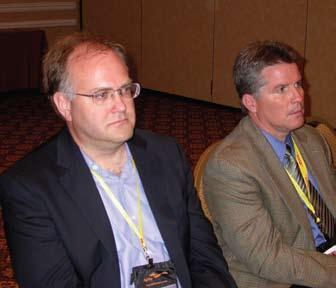
features (links to videos, RSS feeds, and other digital media files) further enhance the knowledge-building process, vital to effective intelligence gathering.
Richard Russell offered insight as to how the technology came to reside within the secured domains of the Intelligence Community. “We try to adopt something that has been done [already] and then adjust it to our needs . . . and bring folks on as rapidly as possible. The last thing we would ever want to do is create the codes. We find new technologies and see what has staying power for which we have a demand for from our constituency.” The approach makes use of best practices, but also avoids R&D expense and the headaches of web architecture maintenance. In turn, ODNI keeps commercial software programmers in the loop. Modifications that work well for their people are passed on based on the premise that adaptations to off-the-shelf products would also benefit the general public.

Just days before the start of the NDTA Forum in Nashville, on September 15, 2009, the Office of the Director of National Intelligence (ODNI) unveiled the National Intelligence Strategy (NIS), one of the most important documents for the Intelligence Community. Director Dennis C. Blair unveiled new guidelines that go beyond the formation of an integrated, collaborative, intelligence community, the original NIS goal. “It reflects a more refined understanding of the threats we face and how we’ll combat them. In describing our objectives, it prescribes methods for achieving them that can only be carried out by an Intelligence Community that is agile, adaptive, and united. Most importantly, it recognizes that national security hinges on good intelligence and it provides me with the tools I need to monitor performance and ensure accountability,” Blair said. NDTA members were extremely fortunate to be able to join a session dedicated to “Web 2.0 and Security Best Practices” on the heels of this announcement.
NDTA members may find parallels in this model to the DOD/Commercial Partnership, where the exchange of resources, assets, and systems provides mutual benefit.
Other commercial applications that have been adapted and added to the National Intelligence Suite of Web 2.0 software include a video-sharing service called iVideo built on the Flash Video Format (FVF), the same used by YouTube; a photosharing service know as Gallery that was built on the same foundation used by Flicker; an online reference tagging service called Tag Connect based on Deli-
cious; and the intelligence counterpart to FaceBook, A-Space (aka, “FaceBook for Spies”). Incidentally, Government Computer News honored ODNI with the IT Achievement Award for A-Space in 2008 citing, “A-Space will fundamentally transform how intelligence analysts do their jobs . . . by exposing new information sources and the insights and experience of new analysts and collectors . . . A-Space will strengthen analysis by ensuring that analysts across the Intelligence Community can each contribute their views and share information, consistent with security requirements, so that alternative perspectives are readily expressed, assumptions are challenged, and judgments are informed by all available data.”

• More than 265 million people use Wikipedia, the multilingual, webbased free-content encyclopedia (with linked resources) that is part of the Web 2.0 tool kit.
• ODNI provides search services for the DOD intelligence community at about 2 million searches a month of more than 86,300,000 documents.
Cloud computing and messaging service adaptations are currently in the ODNI pipeline along with a Google-like search engine that will link databases across all 16 National Intelligence Agencies.

The session ended with examples of how Web 2.0 technology can be applied to the logistics and transportation industries: 1) Consider a scenario involving a pirate attack on a container shipment. Alerts that include GPS positioning, maps, and smart phone photos, for example, can be passed in real time via Tweets to safeguard all shippers within the disrupted lane. 2) Or, logisticians can “wikify” documents to facilitate the government contracting process. For instance, official government contracts in PDF format offer considerable detail, but they are static and cannot be customized. Web 2.0 tools allow transformation from a PDF version to a working document (built on a database construct) that can be manipulated to include additional or updated information. Pivot tables, time sheets for team members, a history of contract terms and other legacy items, budget calculations, and myriad facts and figures can be configured within the government-regulated parameters, thereby saving logisticians from having to recreate documents over and over. Web 2.0 tools also provide a variety of options for restructuring the content altogether. Web 2.0 has proven itself valuable within the Intelligence Community. Applications can also promote greater efficiency within logistics-based enterprises and enable logisticians to take on more demanding roles.
• Various security clearances require individual caveats that can interrupt information flow
• Taking it to the next level: how to engage the next generation of IT Natives to supply new technology
• Can networking be seamless when differing protocols exist between applications and agencies
• An auto-correct feature would be an attractive development given the volume of information currently available
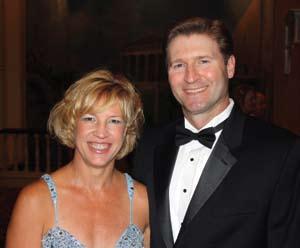


Presented by Mr. Raymond P. Ebeling, Chairman and CEO, NDTA Board of Directors
National Transportation Award

Mr. Thomas B. crowley, Jr. Chairman of the Board, President, and CEO Crowley Maritime Corporation
NDTA DoD Distinguished service Award
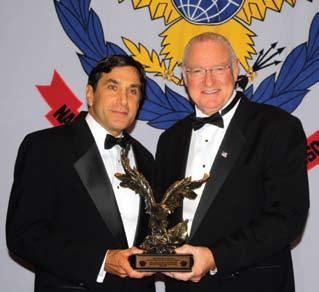
Mr. Richard S. Haynes Executive Director, Military Sealift Command
NDTA president’s Award

COL Joseph A. Torsani, Jr., USA (Ret.) Chairman, NDTA Council of Regional Presidents Business Development Advisor, xIO Strategies, Inc.
NDTA PRESIDENT’S SPECIAL ACHIEVEMENT AWARDS
Presented by Mr. Raymond P. Ebeling, Chairman and CEO, NDTA Board of Directors
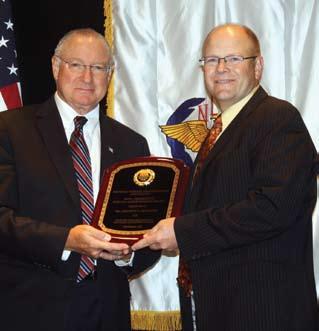
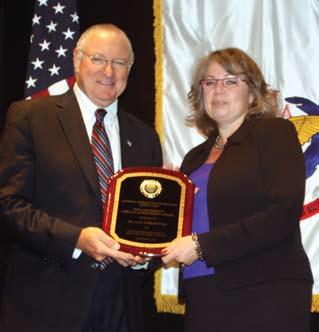
“A is not an option.”

Go ahead, challenge us. Give Agility an impossible task and we’ll make it happen, regardless of what stands in the way. When it comes to moving essential supplies through hostile environments without turning back, you can count on us to deliver.
Presented by Mr. Raymond P. Ebeling, Chairman and CEO, NDTA Board of Directors
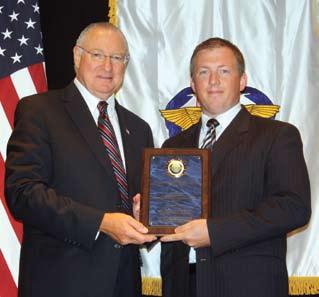
civili AN
Mr. Jason Trubenbach Washington, DC Chapter
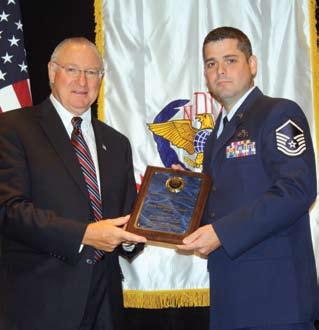
Technical sergeant Alisha N. cua Scott-St. Louis Chapter
INTERNATIONAL CHAPTER OF THE YEAR AWARDS
Presented by Mr. Raymond P. Ebeling, Chairman and CEO, NDTA Board of Directors
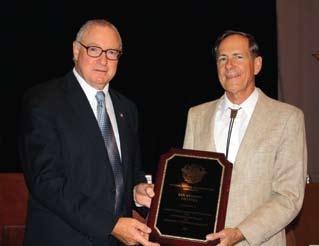
cATEG o RY ii
san Antonio chapter
accepted by Mr. Jon Simms

cATEG o RY iii scott-st. louis chapter accepted by Mr. Ken Wavering
INTERNATIONAL A-35 CHAPTER OF THE YEAR AWARDS
Presented by Mr. Raymond P. Ebeling, Chairman and CEO, NDTA Board of Directors
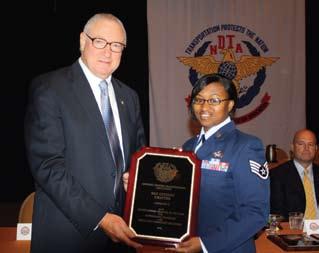
cATEG o RY ii san Antonio chapter accepted by SSgt Regina Green, USAF
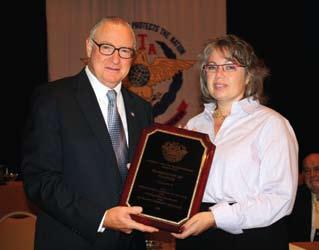
cATEG o RY iii washington, Dc chapter accepted by Ms. Kirstin Knott
Agility Defense and Government services
American shipping and logistics Group
Apl limited
Avis Budget Group
Baggett Transportation company
Bennett Motor Express, llc
The Boeing company
cEvA logistics
corTrans logistics, llc
DB schenker
Delta Air lines
DHl
FedEx corporation
The Hertz Corporation
intercontinental Hotels Group
landstar system, inc.
lockheed Martin
Maersk line, limited
Mccollister’s Transportation Group, inc.
National Air cargo
omega world Travel
panther Expedited services, inc.
The pasha Group
ports America Group
Raith Engineering
R&R Trucking
southwest Airlines
savi, a lockheed Martin company
science Applications
international corp. (sAic)
Transportation institute
ups
YRc worldwide
Presented by Mr. Raymond
P.
Ebeling, Chairman and CEO, NDTA Board of Directors
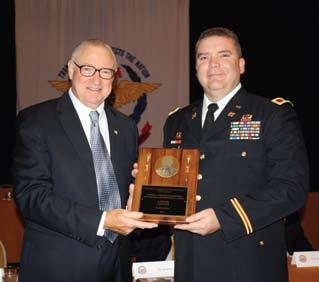
cATEG o RY i A-Frame chapter accepted by COL Bruce Ferri, USA
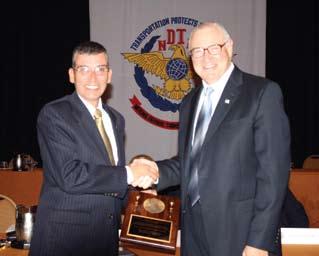
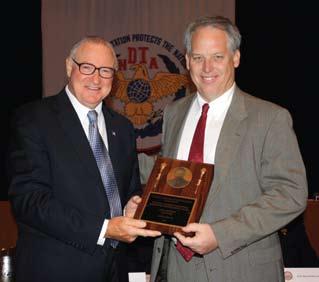
cATEG o RY ii san Antonio chapter accepted by Mr. Ron Westall
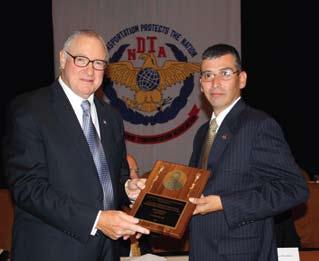
cATEG o RY iii
Regimental chapter accepted by Mr. Joe Escalera i
Mr. christopher Blum
Valley of the Sun Chapter
Mrs. Debbie Bretches
DTJ, Carden Jennings Publishing
Mr. Mark cordisco
Charleston Chapter
Mr. steven cubarney
Washington, DC Chapter
colonel Jacques De kimpe
Benelux Chapter
Ms. sheri Dixon
Scott-St. Louis Chapter
ssgt Regina Green, usAF
San Antonio Chapter
Mr. larry larkin
Washington, DC Chapter
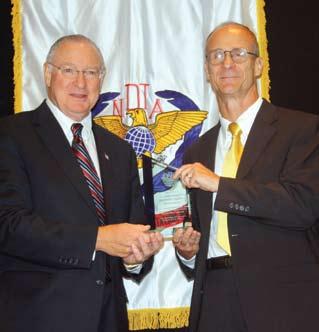

Mrs. caron Martin
Valley of the Sun Chapter
Ms. Jennifer l. Tubb
Scott-St. Louis Chapter
cApT James Naber, usN (Ret.)
Central PA Chapter
Ms. Mary “Liz” Pasqualucci
Scott-St. Louis Chapter
Mr. Robert sherrill
Tampa Bay Chapter
colonel carlo van den Berg
Benelux Chapter
Mr. John “Mo” verling
Scott-St. Louis Chapter
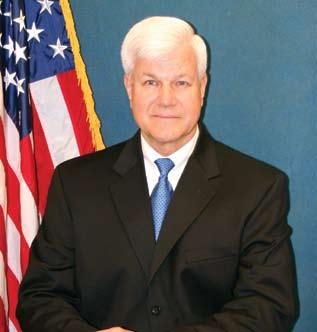
Mr. charles carter
Supply Corps School Athens, Georgia
Presented by General Arthur Lichte, USAF, Commander, Air Mobility Command
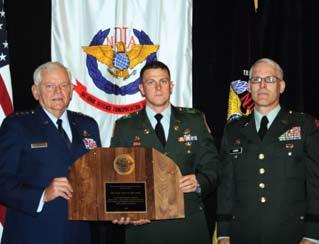

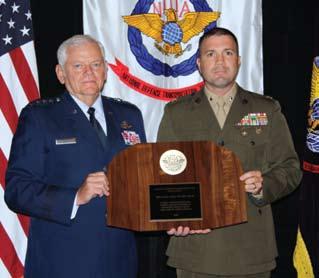
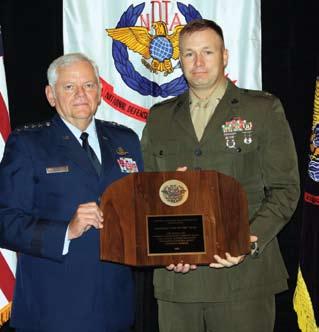
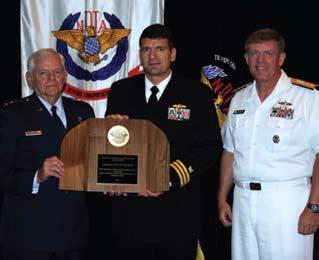
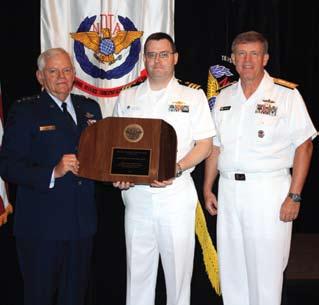
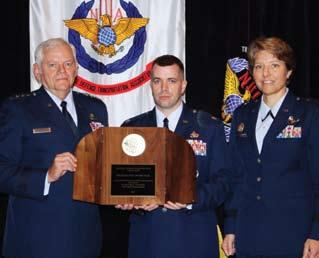




Whether you’re moving military tanks or school textbooks, Landstar Government Services delivers. Our proven track record and unparalleled commitment to safety ensures U.S. government agencies worldwide get reliable, responsive transportation solutions for every shipment, every day.
As a leader in protective services and movement of arms, ammunition and explosives, Landstar is ready to support our armed forces whenever U.S. troops are deployed.
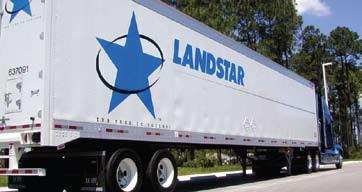

Landstar Government Services delivers freedom from worrying about your most demanding transportation and logistics needs.


Landstar has a reputation for providing the same care and precision whether transporting space vehicles for NASA or moving mail for the U.S. Post Office.
Just one phone call delivers access to complete over-the-road, expedited, air, logistics and multimodal services. The Landstar system is a network of more than 1,300 independent sales agent locations and more than 32,000 available truck capacity providers.
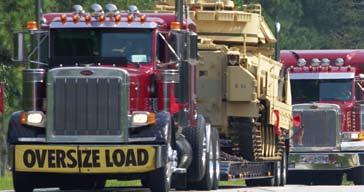




Presented by Major General James L. Hodge, USA, Commanding General, SDDC


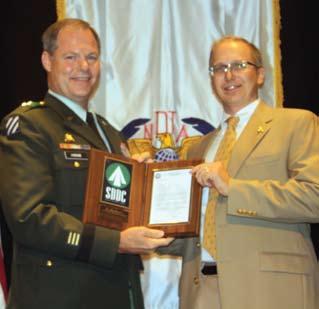



















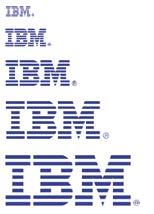

















AloHA cHApTER
*Some articles have been condensed due to limitations in space.
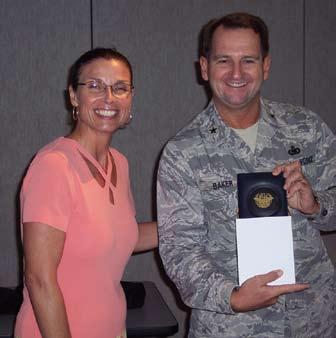
Yvonne Frazier, appointed Secretary/Treasurer, presenting NDTA memento to Brig Gen Baker.
Aloha! Welcome back Aloha Chapter! We are quickly revitalizing and expanding membership. Thanks to a couple of energetic members and a wonderful group of industry representatives, we’ve established interim committees and were able to set up a jam-packed speaker schedule to educate and promote NDTA throughout Hawaii. The DLA Pacific Commander, Col Bill McCarver, USA, spoke to a group of 26 members on 20 Aug about DLA Pacific’s mission, roles, and responsibilities to the warfighter. On 22 Oct, the Pacific Air Forces Director of Logistics, Brig Gen H. Brent Baker, Sr, USAF, spoke to
a group of 35 members about “Generating Air Power” and Air Force Logistics Transformation. Dr. Panos Prevedouros, Professor of Civil and Environmental Engineering, University of Hawaii, is scheduled to speak on 18 Nov about Oahu transit and its impact. Lee Webber, President, Honolulu Advertiser, will share his emergency response experiences on 16 Dec. We look forward to reestablishing a “leading” NDTA Chapter—watch for us in future editions.
Mr. Greg Kessler, Director of Totem Ocean Trailer Express, spoke to members of the Arctic Chapter at Eielson AFB Alaska on August 27. Mr. Kessler manages TOTE’s activities in Alaska, which include meeting the needs of sales, marketing, and pricing groups while implementing TOTE policies and strategies. He discussed the company’s increased shipping capabilities since the 2003 arrival of its new roll-on/roll-off cargo ships. The Orca Class vessels can carry up to 250 vehicles and 500 28- to 53-foot highway trailers. Arctic Chapter President Ken Russell thanked Mr. Kessler for coming up from Anchorage to speak to the group. The session was very informative, especially since the Cargo Movement section at Eielson AFB and Ft. Wainwright


uses Tote as one of their carriers to haul cargo to the lower 48 states and worldwide locations. Tote also ships privately owned vehicles and personal property for the military bases into and out of Alaska. Accompanying Mr. Kessler was Mr. Chuck Muscio (Account Executive) from Tote. Mr. Craig Powley from the Fairbanks Vehicle Processing Center, Maj Mark Tate, Commander of the Logistics Readiness Squadron at Eielson AFB AK, and 15 members of the Arctic Chapter were also in attendance. DTJ
*Some articles have been condensed due to limitations in space.
>> You’ll find Industry News each month in the NDTAGram. Check online for current and archived issues. www.ndtahq.com <<
try leader in achieving federal locomotive emissions standards.
Inbound Logistics has recognized Norfolk Southern Corporation (NS) as one of 25 Green Supply Chain Partners (G25). The company was singled out for its “Green Machine,” a carbon footprint analyzer that allows businesses to estimate the emissions savings of choosing rail transportation. The magazine also noted investments made by NS to upgrade its locomotive fleet, making it the rail indus-

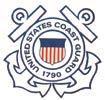
On November 13, the United Seamen’s Service 2009 40th Annual Admiral of the Ocean Sea Awards (AOTOS) were presented to Donald Kurz, President and CEO of Keystone Shipping, and to Ron-
ald Widdows, Group President and CEO of Neptune Orient Lines, parent company of APL. A special AOTOS Award was also presented to The United States Coast Guard; Admiral Thad Allen, Commandant, accepted the award on behalf of the Coast Guard for their incredible role in these times of uncertainty. The officers and crew of the Maersk Alabama, who fought off a pirate attack earlier this year, will be presented with an Honored Seafarers plaque. NDTA co-sponsored the evening reception prior to the awards dinner.

The Iraqi Republic Railways, in conjunction with APL, is proud to announce that Baghdad is once again serving as a hub of regional and international trade routes. Historically, Baghdad is well known as the last stop on the infamous Orient Express and as the beginning of China’s legendary Silk Road. Today, the Iraqi capital city is again making news as an intermodal cargo destination for the movement of goods and materials from within Iraq to the Persian Gulf and the rest of the world. This revitalized intermodal transportation system will facilitate long-term commercial growth and lead toward a resurgence of economic prosperity in the region. Several Iraqi-owned businesses teamed with APL to provide a seamless and secure transportation solution. The move integrated trucks and trains to move 320 20-foot containers from deep within the Al Anbar Province to a waiting ocean liner docked at the Iraqi port city of Umm Qasr. The Iraqi trucking company,
Al-Badia Group, trucked the containers from Al-Asad to be transloaded at the railhead in Bagdad. From Baghdad, the Iraqi Republic Railways efficiently rolled the APL containers south to be held at the Al Saba container yard in Umm Qasr.
The fast and efficient movement of cargo down Iraq’s new main line is attributable to the coordinated efforts of the dedicated IRR team with many United States Agencies and military partners who have restored the railroad tracks, bridges, and switches to a safe and efficient system. The heart of this system is a state-of-theart Communications Based Train Control system, which was installed by the Volpe Center of Cambridge, Massachusetts, to avoid the head-on collisions that have plagued the rail service in the past.
After passing through customs in Umm Qasr, the cargo was lifted onto the APL ship M/V Sagamore. The M/V Sagamore provides the Persian Gulf with a weekly regional liner service calling on the ports of Umm Qasr, Iraq; Umm Said, Qatar; and Jebel Ali, UAE. By utilizing the connection service in Jebel Ali, APL’s ship-
ping lanes connect Iraq’s growing economy with virtually every major market and port of call worldwide.

GeoDecisions, an information technology company specializing in geospatial solutions, is pleased to introduce the latest version of IRRIS, offering improved reporting, analysis, visibility, and querying capabilities. A secure geospatial Web application, IRRIS provides users with the access, knowledge, and visibility to effectively view, analyze, and track mobile assets on a global basis. It incorporates and displays worldwide infrastructure data, livevehicle tracking, near–real-time weather, and active route conditions in a map format. IRRIS was originally developed for the US Military Surface Deployment and Distribution Command to track, manage, and document the movement of surface cargo transported throughout the world.
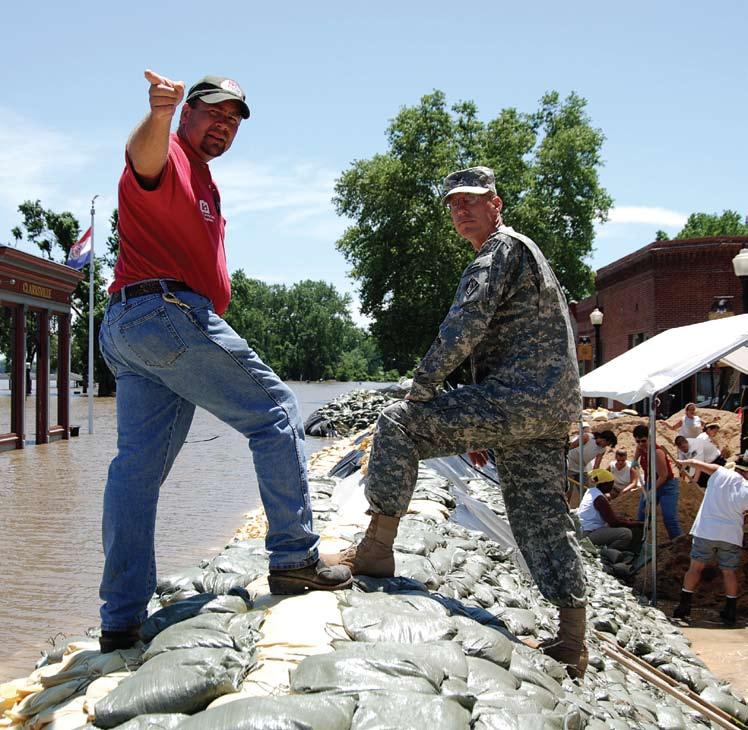
Today’s leaders recognize the value of partnerships. AMU offers you more value through additional course options with our partners such as the Global Maritime and Transportation School (GMATS).
• Transfer credit for approved courses will save you time and money
• Choose from more than 100 online bachelor’s, master’s and certificate programs, including Transportation & Logistics Management
• Reduce your cost of earning a degree with affordable tuition
at www.apus.edu/open-house/schedule
Today, the portal serves a number of federal and state homeland security agencies, as well as USTRANSCOM and the Naval Operational Logistics Support Center.

sAvi
Savi, a Lockheed Martin company and provider of RFID-based supply chain products and solutions, has been awarded orders totaling $6.6 million for standardsbased active radio frequency identification (RFID) tracking technologies and accompanying services under the US Department of Defense RFID III procurement contract. The RFID tags, which are affixed to cargo containers and other supply chain assets, comply with the ISO 18000-7 standard (also called DASH7), enabling near–real-time supply visibility and interoperability with allied defense forces and government organizations.
“This initial order of DASH7 RFID devices marks the DOD’s conversion of RFID products to an open global standard that will support multi-national interoperability and innovative solutions that can leverage sensor-rich networks,” said David Stephens, Chief Executive Officer.
For the past dozen years, Savi has helped to build the DOD’s In-Transit Visibility network, which is the world’s largest active RFID-based cargo tracking system, spanning more than 4000 nodes across more than 40 countries. Savi RFID-based solutions also support other government agencies and international defense forces such as NATO, the United Kingdom,
Australia, Canada, Sweden, Denmark, Spain, Poland, and others.
Savi is a founding member of the DASH7 Alliance, a broad coalition of technology developers, manufacturers, test laboratories, and government organizations committed to proliferating the commercial use of wireless sensor networks based on the ISO 18000-7 standard.

Qualcomm, leading provider of businessto-business wireless enterprise applications and services, has announced that its Untethered Asset Management Service has received Defense Transportation Tracking System II (DTTS) certification from the SDDC. DTTS certification of Qualcomm’s trailer tracking service qualifies Qualcomm customers to transport Department of Defense (DOD) sensitive and other DTTS-monitored shipments. The certification was awarded after a series of tests conducted by SDDC and applies to Qualcomm’s Untethered Asset Management System with integrated sensor capabilities for enhanced security.
The DOD is mandating that satellite tracking service providers such as Qualcomm support greater in-transit visibility for commercial carriers transporting ammunition, arms, and explosives (AA&E) and other sensitive materials (OSM) shipments. The DOD mandate further states that these carriers must provide trailer tracking technology while under a DTTS-monitored van trailer load and be prepared to do so by February 15, 2010.

MiliTARY sEAliFT coMMAND (Msc)
US Navy’s MSC welcomes new commander Rear Adm. Mark H. Buzby as the organization’s 25th commander. Buzby, a 30-year Navy veteran, assumed command during a ceremony aboard Navy hospital ship USNS Comfort in Baltimore on 16 Oct 2009. He relieved Rear Adm. Robert D. Reilly, Jr.,
The DOD’s primary objective is enhanced load security and immediate, exceptionbased alerting of unplanned events.
DTTS was one of the earliest adopters of Qualcomm’s technology, and all current DTTS carriers use Qualcomm in-cab telematics technology. The primary mission of DTTS is to be the single DOD program tasked to ensure the safe and secure movement of all Department of Defense AA&E and OSM within the continental United States using satellite technology and 24-hour oversight. A secondary mission, accomplished through data integration, is to support US Transportation Command’s in-transit and asset visibility objectives.

XIO has been awarded a contract to assist the Defense Energy Support Center’s (DESC) Public Affairs Office (PAO) with communications and marketing activities. DESC, a field activity of the DLA, is tasked with providing the DOD and other government agencies with comprehensive energy solutions in the most effective and economical manner possible. XIO specializes in logistics and supply chain management, including a dedicated communications practice with a history of supporting DOD organizations. XIO’s work with DESC will include a variety of communications support activities, from drafting articles and responding to media inquiries to website evaluation and management. DTJ
*Some articles have been condensed due to limitations in space.
who served as the commander of MSC since March 2006 and will retire after 34 years of distinguished Naval service. During Reilly’s tenure, MSC returned nearly $1 billion to the Navy’s budget through improved business practices; won several awards for excellence; and deployed on five humanitarian and civic assistance missions among many other achievements. Buzby comes to MSC from US Fleet Forces Command in Norfolk, VA, where he was deputy chief of staff for global force management and joint operations.
The DLA is working hard to remain relevant to customers and continue its history of combat logistics support excellence, Director Navy VADM Alan Thompson told employees at his Oct 27 Director’s Call.
Despite the challenges DLA is facing in an uncertain economic and budgetary
environment and supporting combat operations in the Southwest Asia theater and humanitarian actions in the Pacific, the Agency is having great success meeting its mission, he said.
During the three-part briefing, which was broadcast Agency-wide, the director discussed DLA’s full spectrum support to customers around the world, his recently debuted fiscal 2010 Director’s Guidance, and the results of the Agency’s recent culture survey.
Still, several major challenges lie ahead for the Agency in its support to combat operations in Southwest Asia, including the January elections in Iraq and their security outcomes, which loom large for decision makers charged with determining the pace at which the military force drawdown will occur, Thompson said.
“If the elections run relatively smoothly and security proves strong, the drawdown of troops is going to happen rapidly,” he said. “The major implication for DLA is repositioning to support the enduring forces [that will be staying in Iraq] and supporting those forces as they move to the enduring bases.”
Thompson said the troop withdrawal will place additional pressure on the Agency’s Defense Distribution Depot Kuwait, Southwest Asia, which is already stocked at 70 percent of its storage capacity.
“That’s not a lot of excess capacity, because an awful lot of material that’s coming out of Army and Marine Corps stocks in Iraq will have to be processed through DDKS, and I’m sure they’ll be screaming when they approach 90 percent [capacity] level. But we’re managing that closely,” he said.
Given the nature of the land-based operations in Afghanistan, Thompson said DSCC’s support of the new all-terrain MRAP variant known as the M-ATV is key to the Agency’s overall support to the US Central Command area of responsibility.
“We’re making sure we have the sustainment right, so that as these new MRAPs arrive in Afghanistan [they are adequately provisioned], because we can’t afford a situation where the vehicles are manufactured, the military goes through a huge effort to airlift them into Afghanistan, and then, essentially, they become not–mission-capable for want of a DLA spare part,” he said.
Also vital are the support of rotary-wing aircraft by the Defense Supply Center Richmond, VA, and the fuel supplied by the Defense Energy Support Center. Due to the austere nature of the country’s landscape, much troop movement and most resupply must happen via airlift, Thompson said. Supplying fuel in Afghanistan is a joint venture: DLA shares responsibility for logistics support with NATO. DESC has worked with NATO to ensure not only that fuel stocks are sufficient in regions where DLA has primary responsibility, but also that they are at appropriate levels to support US combat force operations in regions where NATO has the logistics lead.
“The big question related to Afghanistan is the increase in the number and distribution of forces, which is yet to be determined,” Thompson said. “We need to be agile logisticians and stay tuned in on what the ultimate decisions are so we can adjust our decisions accordingly. But looking across our full line of support . . . I’m confident we’ve got it right.” DTJ
Admiral Thompson’s remarks can be read in full at: www.dla.mil; visit Press Center.


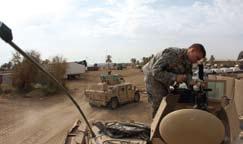

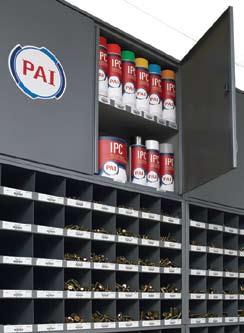
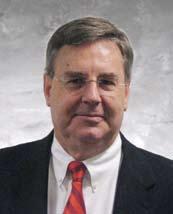
lee Jackson Senior Consultant, Perot Systems Travel & Transportation Center of Excellence
aving just returned from the 63rd Annual NDTA Forum and Exposition in Nashville, I reflected on my experience: the word that came to mind throughout the entire experience was SEAMLESS. From beginning to end, and during the entire NDTA Forum, the process could not have been better planned, organized, or managed. This includes not only my initial and return processing at the airport through the TSA security inspection process, but also my participation and involvement with the NDTA Forum.
As a first time exhibitor at the NDTA Forum, my colleagues at Perot Systems and I were impressed by the volume of traffic we experienced in the exhibit hall, as well as the high level of curiosity and interest many of the participants expressed regarding Perot Systems’ involvement in travel and transportation. From my perspective within the Perot Systems Travel & Transportation Center of Excel-
lence (T&T COE) and as a new sustaining member of NDTA, the Forum could not have been more timely or full of networking opportunities.
Perot Systems T&T COE serves as a cooperative forum and a vital stakeholder resource, combining our demonstrated performance experience serving government clients with commercial best practices. The NDTA Forum directly supports the goals and objectives of our Center of Excellence.
During the Forum, it was discussed that Perot Systems was working cooperatively on behalf of NDTA and conducting a Travel & Transportation Survey. The final analysis and review of the initial survey results are being tabulated, and results will be forthcoming in a future issue of the DTJ. The survey is planned to be conducted annually, with results released and reported out during the NDTA Annual Forum.
Throughout the Forum, I was very impressed with the collegial discus-

sions and networking. Credit, of course, is first due to LTG Wykle, USA (Ret.), President, NDTA, and his entire staff and the volunteers who were responsible for all of the planning, organization, and the agenda of the Forum. Credit is also due, however, to the transportation community and the current leadership of the
We must all work together! The 63rd Annual NDTA Forum and Exposition clearly demonstrated that we were on the right path!
public and private sectors. It is one thing to espouse partnering and working toward common goals and objectives, but a stronger message was never sent than the environment which existed at the Forum this year. From Major General Hodge’s remarks and full attendance at the initial Surface Committee meeting on Saturday, September 19, to the keynote remarks made by General Ann Dunwoody, USA, Commander, AMC, and General Duncan McNabb, USAF, Commander, US Transportation Command, on the closing day of the event, nothing was more clearly stated throughout the Forum than the vital importance of public-private partnerships and a seamless transportation environment.
If the United States is going to succeed as a Nation, in defending both itself and its territories from foreign threats, while at the same time remaining competitive with global trading partners throughout the world, it is critical that the public and private sectors work together as a team toward common goals and objectives. We must all work together! The 63rd Annual NDTA Forum and Exposition clearly demonstrated that we were on the right path! DTJ

oing Green is a hot topic in the meetings and conventions industry. From guest rooms and exhibit halls to F&B outlets, everybody is getting on the bandwagon. New “Green Filter” and “Meet Green” companies that analyze every function from catering, signage, marketing, registration, waste removal, and energy use are popping up. If poor meeting practices are in place, improvements will be recommended.
NDTA already employs some Green initiatives, such as this year’s light-weight Forum tote bag, supplied by Landstar Systems and provided to all attendees. The Landstar-sponsored tote bags are “all ecofriendly.” They are made of non-woven 120 gram, recyclable fabric, and because these new bags are also tear-resistant, waterrepellent, and contain only landfill-friendly materials, they conform to the principles of “Reuse, Reduce, and Recycle”. NDTA salutes Landstar for their role in the “Going Green” movement.
There are many other ways we can be environmentally responsible in planning for our Forums. For example, using hotels that have recycling programs, water conserving faucets, and efficient lighting systems, or hotels that offer guests the option to forgo a daily room refresh—resupply of new linens, towels, soaps, and toiletries—in order to reduce waste.
excess banquet food where “good Samaritan” laws permit are other ways we can save the environment at Forum time.
In 2010, we’ll be meeting at Gaylord National Resort and Convention Center, where significant steps have been taken to reduce the carbon footprint. For starters, guest rooms are equipped with occupancy sensors that automatically monitor and modify the room temperature to “energy efficient” mode when guests are not detected; thermostats adjust to comfortable temperatures once guests return. The Gaylord’s hotel atrium is home to more than 500,000 individual plant specimens that promote cleaner air and 50 to 60 percent fewer mold spores and bacteria. One tree can filter up to 60 pounds of pollutants from the air every year.
The brand new Phoenix Convention Center, our Forum destination for 2011, is Leadership in Energy and Environmental Design (LEED) Silver Certified. Innovative practices in place in Phoenix include recycling sand, dirt, and stone from their construction sites into paving materials for new roads in the area and using condensation from air conditioning systems to water plants and shrubs. When you attend our NDTA Forum Opening Session in Phoenix, you’ll be seated on chairs made from recycled automotive battery casings and old seatbelts! How appropriate for a transportation-oriented organization!
Opting for soy- or vegetable-based inks to print event materials, sending electronic documents rather than hard copies to save paper, using filtered water stations rather than bottled water in meeting rooms and during networking breaks, china dishes rather than paper plates, and donating
Going Green is here to stay. Each year more new and useful initiatives appear. You can be proud that NDTA is doing its part, but there is always room for improvement. If you have ideas that we can use, please contact us. DTJ
Presented Sept. 21-22, 2009, at the NDTA Forum in Nashville
By Joni Holeman, APICS DC Metro Chapter #127
lEARNiNG oBJEcTivEs
1. Understand the terminology of DOD logistics with best commercial practices
2. Promote the concept of “Unity of Effort” as a foundation for Joint Logistics
3. Focus on the value of Visibility as a key enabler in DOD logistics
4. Understand Rapid and Precise Response’s role in DOD’s core logistics capabilities.
ovERviEw
The 63rd NDTA Forum conducted its third consecutive professional development CEU program in Nashville with “Joint Logistics Integration: DOD’s Logistics Roadmap from an Operations Professional Perspective” with the assistance of Joni Holeman from APICS DC Metro and Irvin Varkonyi, American Military University, Chairman, NDTA Professional Development Committee. Nearly 70 conference attendees pre-registered for the event. The University of Alabama at Huntsville awarded Continuing Education Units for participants who successfully completed the course.
DOD’s Logistics Roadmap1 was issued 16 months ago on 13 July 2008 by the Office of the Under Secretary of Defense for Acquisition, Technology, & Logistics (USD AT&L). Under strategic direction from 2008’s Guidance for the Development of the Force (GDF), the Roadmap details an action plan for developing a streamlined workforce of Joint Logisticians. The target date for completion of this initiative is 2015. At this writing, 6 years remain to adapt a population of some 614,687 logis-
tics employees2 to using lean supply chain replenishment processes.
The two-fold purpose of this 3-hour workshop was to compare DOD’s supply chain with best commercial practices and to build Roadmap awareness. Attendees included civilian and military employees of DLA, Air Force, Navy, and TRANSCOM, along with personnel from two commercial 3PL suppliers: the National Institute of Health and American Military University. This presentation stimulated highly interactive discussions with wide-ranging perspectives on the challenges and constraints and was very well received according to workshop evaluations.
The Roadmap supports three Portfolio Logistics Goals established by the GDF for DOD’s logisticians: Unity of Effort, Visibility, and Rapid & Precise Response. These goals were contrasted with commercial practices observed throughout my career in manufacturing, distribution, and value engineering. I’ve spent the past 11 years teaching operations and supply chain principles to businesses, several government agencies, and DOD service branches.
This first section is the product of successful unified action, even if the participants are not part of the same command or organization. To achieve this, DOD logisticians must develop a clear understanding of how joint and multinational logistics processes work, know the roles and responsibilities of the providers executing those tasks, and ensure that proper DOD enterprise members have visibility into these processes. Collaboration should begin at the national level and span activities from early plan-
1 230-page download available at http://www.acq.osd.mil/log/sci/roadmap/Executive_Overview
ning through execution. With operations and logistics information integrated across Combatant Commands, each of the services, and DOD agencies, logisticians can better forecast and respond in support of effective mission requirements.
Commercial process equivalents to Unity of Effort include cross-functional integration, communication, and Strategic Plan alignment. In my personal opinion, marketplace dynamics and competition have forced commercial companies to become more internally integrated than DOD. In terms of enterprise-wide communication of mission objectives and focusing resources on common outcomes, DOD’s processes and organizational structure are vastly superior to the private sector.
This second section fundamentally answers the Combatant Commander’s questions of where, how, and when. It optimizes logistics capabilities, maximizes outcomes, increases readiness, provides access to authoritative information, and allows rapid response to changing requirements.
Commercial process equivalents to Visibility include IT compatibility and systems integration. Software advances in network simulation and ERP bolt-ons such as Supply Chain Event Management (SCEM) give businesses the upper hand over DOD toward achieving this goal.
The final section looks at the ability of DOD’s core logistics capabilities to meet the dynamic needs of the joint force, as measured by the key performance indicators of speed, reliability, and efficiency.
Commercial sector comparisons include core competencies, competitive advantages, and distribution network optimization. Customer Relationship Management (CRM) software today can enable companies to anticipate client expectations, mov-
2 DLA Enterprise presentation 01 Feb 2009. Demographics current as of 8/30/09, per Defense Civilian Personnel Data System (DCPDS), Defense Manpower Data Center (DMDC), and Military Services
3 Extracted from http://www.acq.osd.mil/log/sci/roadmap/Executive_Overview, Volume 1, Chapter 2, pages 2-6
li# RoADMAp oBJEcTivEs, AliGNED To THE JoiNT cApABiliTY AREA (JcA) THEY suppoRT
procurement processes
1.2Effective procurement processes
1.3 Align maintenance operations metrics with warfighter outcomes
1.4 Use commercial transportation resources to the maximum extent practicable, integrated with organic resources
1.5 Adopt enterprise-wide metrics that promote common goals and interoperability
1.6 Develop and implement a DoD logistics Human capital strategic plan for a competency-based enterprise logistics workforce
2.1 Visibility into customer materiel requirements and available resources to meet those needs
2.2 Visibility of emerging maintenance workload and in-process resources to meet customer requirements
2.3 Visibility of in-transit, in-storage, and in-process units and materiel for optimized movement planning and execution
2.4 implement information technology strategies for improved visibility and interoperability
2.5 Establish a single authoritative data set for informed logistics decision making
3.1Affordable availability in both peacetime and war
3.2Retrograde and disposal processes aligned to DOD’s needs
3.3Identify and sustain requisite core maintenance capability
3.4 Sustain a highly capable, mission-ready maintenance workforce
3.5 Ensure an adequate infrastructure to execute assigned maintenance workload
3.6 Continuously improve availability, quality, flow days, and cost of maintenance operations worldwide
3.7 In conjunction with Systems Engineering, become the advocate for the design and production of reliable weapons systems and equipment
3.8 Establish a seamless process between deployment and sustainment phases
3.9 Position stock and warehouses to provide effective and efficient readiness
3.10Optimize transportation network
3.11 Drive acquisition processes to focus on sustainment key performance parameter (kpp) and key system attributes (ksA) as well as implementation of performance Based logistics (pBl) strategies
Source: Defense Roadmap Volume 1, Chapter 2, pages 2-6 (modified for format only)
ing them from reactive positions into proactive innovation and marketplace leadership.
My observations reflect that although both sectors have a sense of urgency, nothing in the commercial sphere compares to DOD’s level of focus. I do, however, believe that businesses consistently execute more quickly, and at a far lower cost.
Most participants were aware of the Roadmap’s existence, but details of its 22 Objectives3 (shown in the Table) seemed to be introductory. Line items highlighted in blue indicate cross-functional steps shared by all Joint Capability Areas (JCA). Only the wording references to warfighters, peacetime, war, and weapons distinguish DOD’s objectives from any commercial business’s continuous improvement targets.
In summary, DOD’s Roadmap portends sweeping changes for Logisticians. I foresee a convergence of software tools, expected retirement/attrition rates, and federal budget cuts coming over the next six years. My contention is that by 2015, the population of DOD logistics employees could shrink from 614,687 to only 100,000! Here are some questions to ponder:
• What is your department’s plan for implementing these changes?
• Have you considered the training, metrics design, career transition, and process documentation needs necessary to complete your present workload with only 84% of your present staff?
For any commercial firm, these ramifications would be enormous. Significant discovery, budgeting, and planning in every functional area of an enterprise would have to begin immediately to achieve such important goals.
DTJ
Joni Holeman is President of Affirmation Training Inc. and a co-owner of Seeds4Success Inc., providers of operations and supply chain best practice training along with human potential principles. Joni has more than 25 years of planning, materials management, and manufacturing experience in businesses ranging from custom lighting and value engineering to electronic equipment and remanufacturing. Joni writes online and instructor-led curricula, develops interactive workshops, and is a frequent conference speaker. She may be reached at jwhitewadc@aol.com.
ALL
AAR Mobility Systems
ABF Freight System, Inc.
Air Transport Assn. of America
Air Transport International, LLC
AIT Worldwide Logistics, Inc.
All State Express
American Maritime Officers
American Public University System
American United Logistics
ARINC
Army Air Force Exchange Service
Arven Freight Forwarding, Inc.
Associated Global Systems
Baggett Transportation Co.
BNSF Railway Co.
Bender Shipbuilding and Repair Co., Inc.
Boyle Transportation
Byrne Transportation Services, LLC
Cargo Transport Systems Co.
Carlson Hotels Worldwide
Chalich Trucking, Inc.
Chamber of Shipping of America
Comtech Mobile Datacom Corporation
CRST International, Inc.
CSC
Crowley Maritime Corp.
CWT SatoTravel
C2 Freight Resources, Inc.
Delta Air Lines, Inc.
Dynamics Research Corp.
Enterprise Database Corporation
AAAA Forwarding, Inc.
Access America Transport, Inc.
Acme Truck Line, Inc.
Advantage Rent-A-Car
AFC Worldwide Express
American Moving & Storage Assn.
Association of American Railroads
Asynchrony Solutions, Inc.
Avis Budget Group
AWARDCO Freight Management Group, Inc.
BEC Industries, LLC
Benchmarking Partners
C5T Corporation
Cardinal Transport, Inc.
The Cartwright Companies
Center for the Commercial Deployment of Transportation Technologies (CCDoTT)
Ceres Terminals, Inc.
C.H. Robinson Worldwide, Inc.
Chassis King
C.L. Services, Inc.
Coastal Maritime Stevedoring, LLC
Corporate Flight Management
CSI Aviation Services, Inc.
Enterprise Rent-A-Car
Fikes Truck Line
GE Aviation
General Dynamics/American Overseas Marine
GeoDecisions
Global Maritime & Trans. School-USMMA
Greatwide Truckload Management
Hi-G-Tek, Inc.
Intermodal Association of North America (IANA)
Intermarine, LLC
International Longshoremen’s Association, AFL-CIO
Intl. Organization of Masters, Mates and Pilots
ITLT Solutions, Inc.
Interstate Distributor Co.
JB Hunt Transport, Inc.
KGL Transportation Co.
Kansas City Southern
Keystone Shipping Company
Knight Transportation
Kuehne + Nagel, Inc.
Liberty Maritime Corporation
LMI
Lockheed Martin Aeronautics Co.
M2 Transport
Mack Trucks, Inc.
ManTech International Corp.
Martin Logistics, Inc.
Matson Navigation Co., Inc.
Delaware River Maritime Enterprise Council (DERMEC)
Dollar Thrifty Automotive Group
EADS North America
Erudite Company
Europcar Car & Truck Rental
Executive Apartments, Inc.
FlightWorks
Fox Rent A Car
General Freight Services, Inc./ Coyote Logistics LLC
Great American Lines, Inc.
Green Valley Transportation Corp.
GTS Group
Hanjin Transportation Co., Ltd.
Hawaii Air Cargo, Inc.
Hilton Hotels Corporation
Holiday Inn Executive Center, Virginia Beach
The Howland Group, Inc.
HudsonMann, Inc.
Hyatt Hotels and Resorts
The Indiana Rail Road Company
Kalitta Charters, LLC
Korman Communities AKA a division
Labelmaster Software
Liberty Global Logistics LLC
Mayflower Transit
McCollister’s Transportation Systems, Inc.
Marine Engineer’s Benefits Association
Menlo Worldwide
Mercer Transportation Co.
Mobility Resource Associates
MPRI, a division of L-3com
National Air Carrier Assn., Inc.
National Van Lines
New England Motor Freight, a Shevell Group Co.
North Carolina State Ports Authority
Numerex
NYK Logistics Americas
OAG
Ocean Shipholdings, Inc.
Old Dominion Freight Line, Inc.
Omega World Travel
Omni Air International, Inc.
OSG Ship Management, Inc.
Overdrive Logistics, Inc.
Owner-Operator Independent Drivers Association
Pacer Transport
Parts Associates, Inc.
Perot Systems Corporation
Pilot Freight Services
Port of Beaumont
Powersource Transportation, Inc.
Pratt & Whitney
Prestera Trucking, Inc.
PRTM Management Consultants, LLC
Limitless International, Inc.
Logistics Management Resources, Inc.
LTD Management Company, LLC
MacGREGOR (USA), Inc.
Marriott International
McLane Advanced Technologies
MCR Federal, LLC (MCR)
MBA | Morten Beyer & Agnew
Meyer Trucking, Inc.
Military Sealift Command (MSC)
Naniq Systems, LLC
NCI Information Systems, Inc.
Oakwood Corporate Worldwide
ODINTechnologies
Panalpina
Patriot Contract Services, LLC
Payless Car Rental
Perez Bros., Inc.
Philadelphia Regional Port Authority
Port of Port Arthur
Port of San Diego
PowerTrack, US Bank
Quality Support, Inc.
R+L Global Services
Reckart Logistics, Inc.
Rentacrate LLC
Priority Solutions International
RAITH-CTS Logistics
Ravens Group, Inc., The
Sammons Trucking
Savi, a Lockheed Martin Company
Sealed Air Corp.
Sealift, Inc.
Seafarers Int’l Union of N.A. AGLIWD
Sea Star Line, LLC
Southeast Vocational Alliance
Southwest Airlines
SRA International, Inc.
Stanley Associates, Inc.
SSA Marine
Textainer Equipment Management
TQL
Totem Ocean Trailer Express, Inc. (TOTE)
Transportation Institute
Transportation Intermediaries Assn. (TIA)
Tri-State Motor Transit, Co., (TSMT)
Tucker Company
Union Pacific Railroad
United Airlines
UPS Freight
United Van Lines, Inc.
University of Kansas, Transportation Research Institute
UTi Worldwide, Inc.
VT Halter Marine, Inc.
Wagler Integrated Logistics, LLC
XIO Strategies, Inc.
Royal Trucking Company
Scan Logistix, Inc.
Seabridge, Inc.
Sea Box, Inc.
Silk Road Air & Logistics
SkyLink—(USA)
Sleep Inn and Suites
SLT Expressway
SR International Logistics, Inc.
Stratos Jet Charters, Inc.
Staybridge Suites Chantilly/Dulles Airport
TAPESTRY - FSG
Trailer Bridge, Inc.
Trailways Transportation System
Transcar GmbH
Trans Global Logistics Europe GmbH
TRI-STATE Expedited Service, Inc.
Truva International Transportation & Logistics
Unimasters Logistics PLC
US Suites
Utley, Inc.
The Virginian Suites
Veteran Enterprise Technology Services, LLC
Yurtiçi Logistics Supply Chain Management and Distribution Inc.

Agility Defense & Government Services + PLUS
American Shipping & Logistics Group (ASL) + PLUS
APL Limited + PLUS
Atlas Air Worldwide Holdings + PLUS
Bennett Motor Express + PLUS
Choice Hotels International + PLUS
CEVA Logistics + PLUS
FedEx + PLUS
Global Aviation Holdings, Inc. + PLUS
Horizon Lines, Inc. + PLUS
IBM + PLUS
InterContinental Hotels Group + PLUS
Landstar System, Inc. + PLUS
Maersk Line, Limited + PLUS
National Air Cargo + PLUS
Panther Expedited Services, Inc. + PLUS
Ports America Group + PLUS
Rock-It Cargo USA, LLC + PLUS
Science Applications International Corp. (SAIC) + PLUS
Universal Truckload Services, Inc. + PLUS
YRC Worldwide + PLUS
American Roll-On Roll-Off Carrier, LLC
The Boeing Company
Booz Allen Hamilton
Bristol Associates
CorTrans Logistics, LLC
CSX Transportation
DB Schenker
DHL Global Forwarding
Evergreen International Airlines, Inc.
Hapag-Lloyd USA, LLC
The Hertz Corporation
International Shipholding Corp.
Lockheed Martin
Norfolk Southern Corporation
Northrop Grumman Corporation
The Pasha Group Qualcomm Incorporated
R&R Trucking
SkyBitz
Team Worldwide UPS
UTXL, Inc.
Dr. kent N. Gourdin
Protecting Airline Passengers in the Age of Terrorism, by Paul Seidenstat (Editor) and Francis X. Splane (Editor), ISBN-13 9780313354533, published by Greenwood Publishing, August 2009, $59.95, hardcover, 332pp.
When it comes to airline security, there is nothing more important than getting people to their destinations safely. Transportation security is also a key component in the overall mission of protecting the Nation against terrorist attacks. But airline security is a tricky goal—how do you achieve acceptable levels of security
DEFENsE TRANspoRTATioN JouRNAl
at a reasonable cost and without unduly inconveniencing passengers or invading their privacy? That’s exactly what this book is about. Experts examine the latest thinking and analyze the latest research on air passenger security, discuss current practices, and show how technology can solve myriad problems. Essentially, this book examines the issue of maintaining customer satisfaction when passengers are subjected to processes/procedures that are inherently dissatisfying. This issue of passenger dissatisfaction is becoming more acute as the airlines tack on more and varied fees that often make no sense to the individual. People may be willing to “suffer” in the interest of security, but what about in the face of costs that come across as arbitrary and excessive? Lessons learned from this book can also be applied to this latter issue as well. DTJ
Statement of Ownership, Management, and Circulation as required by the Act of August 12, 1970; Section 3685, United States Code, for Defense Transportation Journal, published bi-monthly at Alexandria, Virginia, for September 2009.
1. Location of known office of publication: 50 South Pickett St., Suite 220, Alexandria, VA 22304.
2. Location of the headquarters of general business office of the publisher: 50 South Pickett St., Suite 220, Alexandria, VA 22304.
3. Publisher: National Defense Transportation Association, 50 S. Pickett St., Suite 220, Alexandria, VA 22304; Publisher, LTG Ken Wykle, USA (Ret.); Editor, Dr. Kent Gourdin, College of Charleston, Charleston, SC; Managing Editor, Karen Schmitt.
4. Owner: National Defense Transportation Association, 50 South Pickett St., Suite 220, Alexandria, VA 22304-7296 (an incorporated association).
5. Known bondholders, mortgages, and other security holders owning or holding 1 percent of more of total amount of bonds, mortgages or other securities: There are none.
6. Average number of copies each issue during the preceding 12 months: Total 8,971; paid circulation by mail, 8,356; sales through dealers, carrier or other means, 328; free distribution by mail or other means, 237; total distribution, 8,921; copies not distributed, 50. Percent paid and/or requested circulation: 97.3%. Karen Schmitt, Managing Editor.
continued from page 4
great time. My involvement in the Young Leaders panel at the Forum has been the most rewarding. I first spoke as a panelist in 2005 after a deployment to Iraq. Since then, I’ve moderated the panel. It’s wonderful to learn about others’ unique experiences . . . to know that senior leadership is taking time to listen . . . to observe reactions of retirees who’ve “been there” . . . to realize that those who haven’t been on the front lines genuinely appreciate our service members’ commitment.
Get involved! Like so many things, NDTA fits into the “Reap What You Sow” rule of life. There may be organizations more specific to your career-field or job description, but because NDTA covers such a broad range of logistics specialties, your opportunities are greater and your horizons are much broader. You’ll understand the Big Picture of how you contribute to National Defense. As General McNabb, commander USTRANSCOM, has noted, YOU are one of our country’s greatest strategic assets! I’ve been involved since I was a 2Lt, when my Captain suggested membership. Early on, my commands were not located near a chapter, but I really got involved while assigned to the 437th APS at Charleston AFB. Dale Cozart and the gang have a very active chapter in Charleston (it’s also one of the first chapters established), and he pulled me in when I arrived. DTJ
Lt Col Babinski, USAF, is commander of the 11th Logistics Readiness Squadron, Bolling AFB, which provides logistics to the US Air Force Honor Guard, Band, and USAF units in the National Capitol Region. He previously served as Commander, Detachment 2, 730 AMS, at Paya Lebar AB, Singapore, after assignments to Alaska, Germany, South Carolina, Korea, and Texas. Jeff is a 1994 graduate of the USAF Academy and of the Advanced Logistics Readiness Officer Course. He served as President of the Ramstein and Anchorage NDTA chapters and is a recipient of the NDTA Distinguished Service Award and the NDTA President’s Award.



Science Applications International Corporation delivered, prepared, and fielded over 9,000 MRAP military vehicles in one year. Our fast and efficient joint logistics integration program provides solutions from C4ISR electronics networks to analytics to total asset visibility. Smart people solving hard problems. For detailed information, visit www.saic.com/logistics

We’re not in the military, but we’re proud to serve the U.S.
We take our job and yours very seriously. At FedEx, you can count on us for access to networks in more than 220 countries and territories and the flexibility to handle anything that comes your way. And you can trust that there’s pride in everything we do.